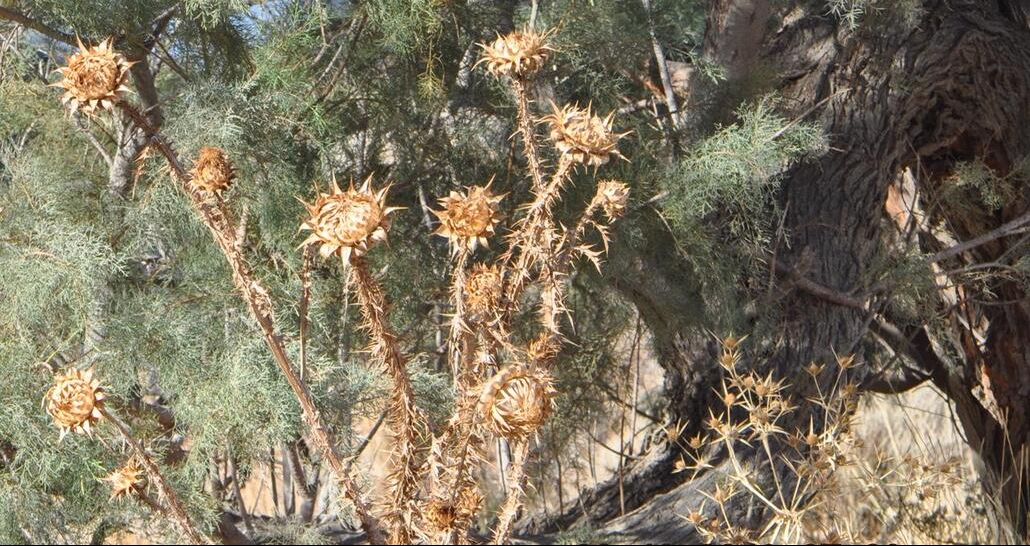
Autumn seedheads in Cretan landscape
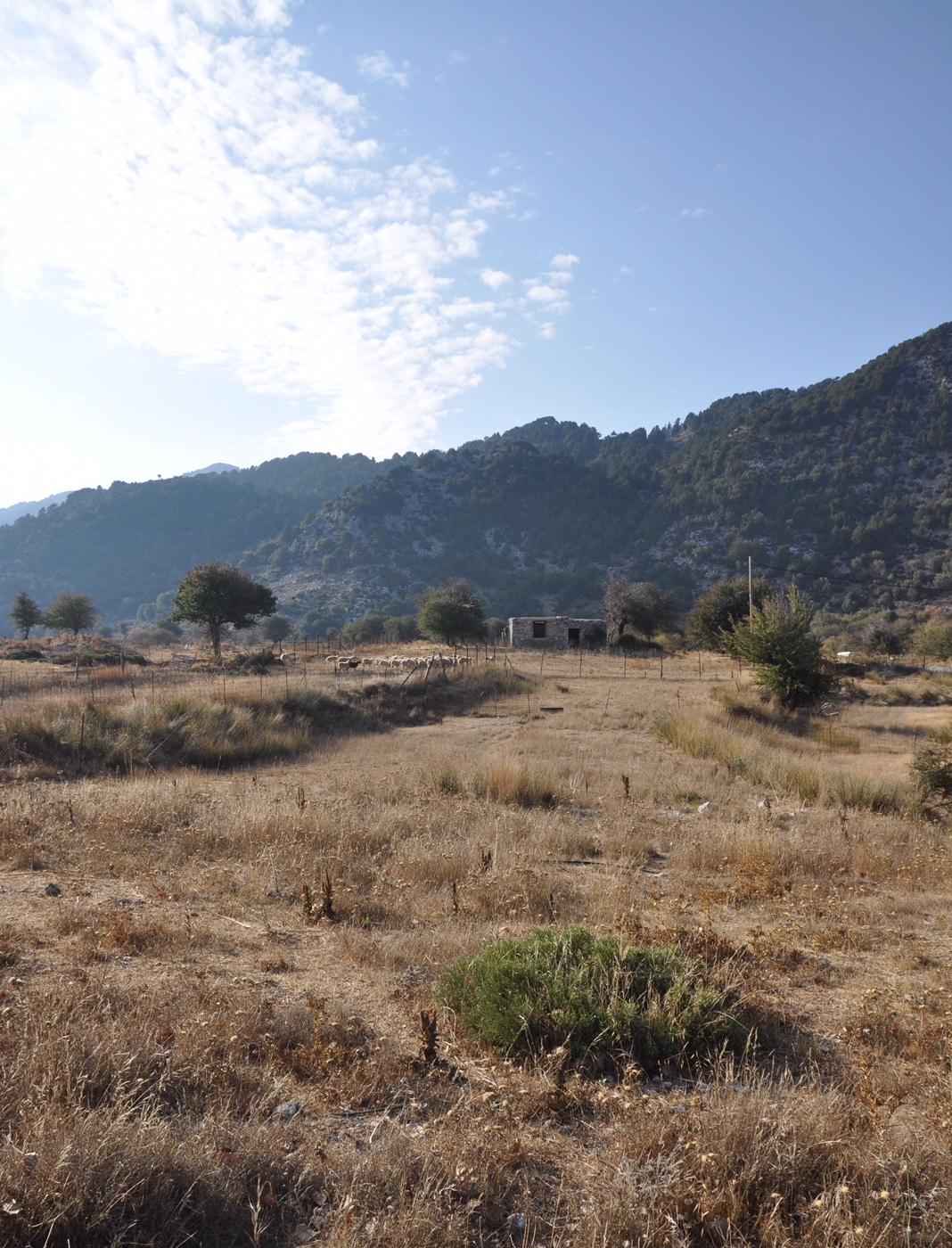
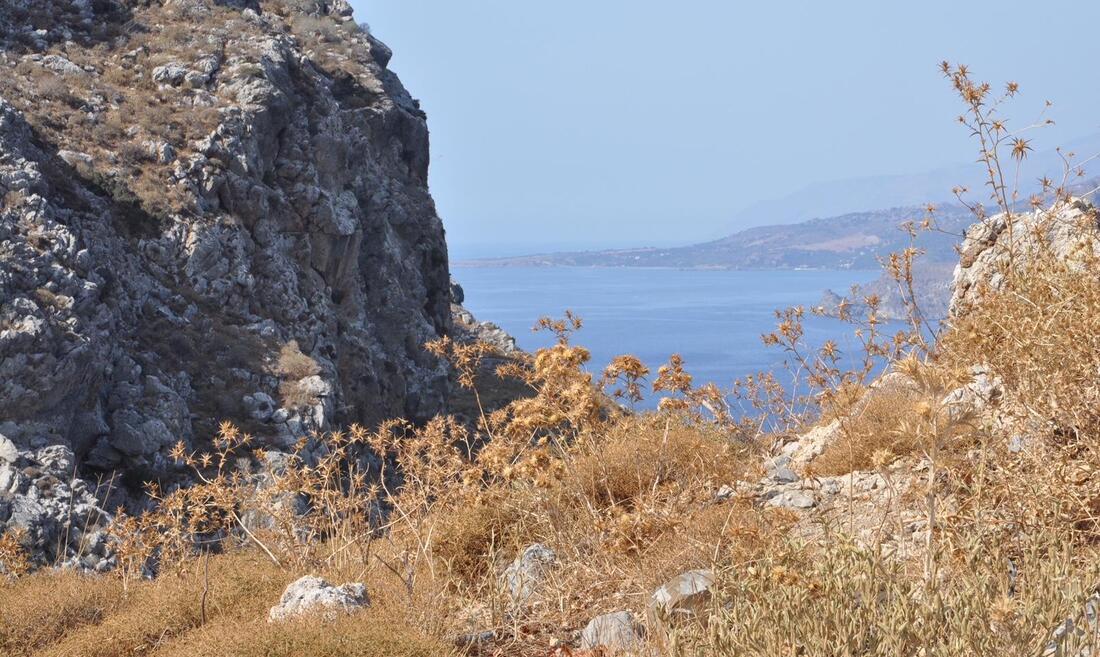
Meeting at Chania Airport, our minibus took us south past Souda Bay, site of an important Second World War graveyard. Our first destination was the Omalos plateau and it quickly became clear that little of the expected autumn rains had fallen as the landscape was still very dry and parched. Spectacular seed-heads, in subtle shades of silver, fawn and gold (Onopordum bracteatum ssp. creticum) were a dominant feature across the island. Perhaps as a result, we experienced very pleasant warm conditions, with little need for outer clothing apart from one morning and the nights up in Omalos. This cool high plateau grows plenty of apples, an unusual crop for Crete, while the dry unfenced roadsides had plenty of Berberis cretica, Pyrus spinosa and Colchicum pusillum, a tiny species with yellow anthers sprinkled amongst the phrygana.
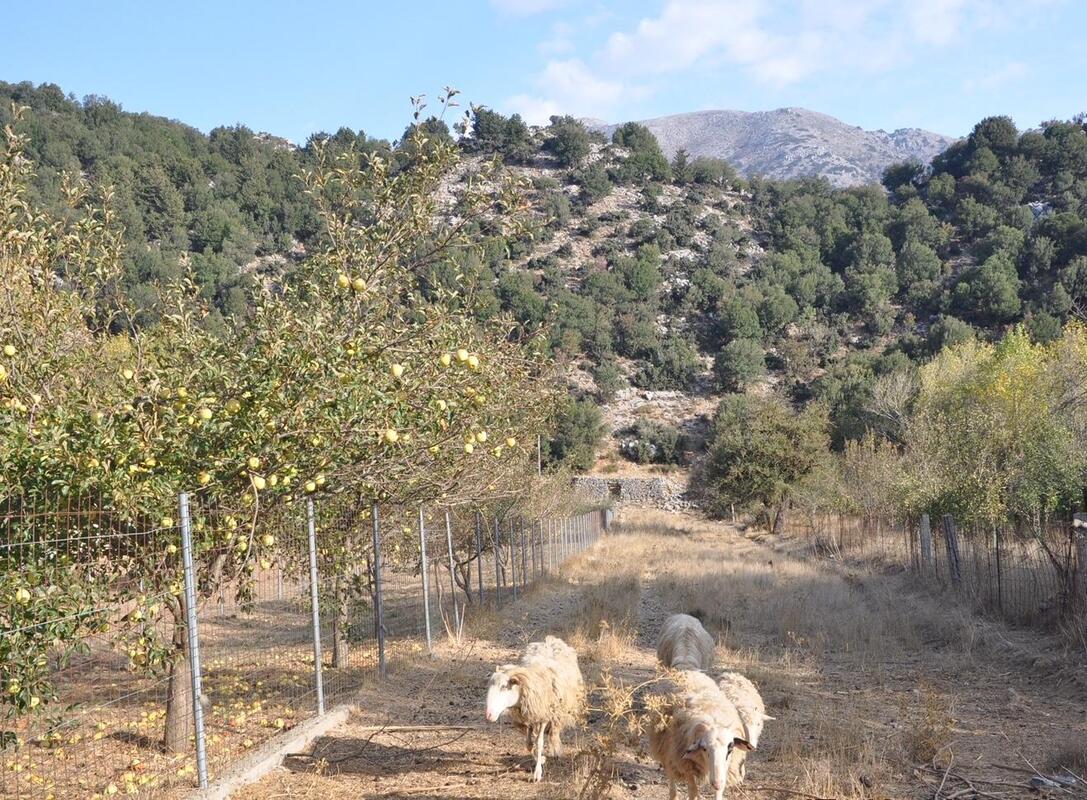
Apple trees
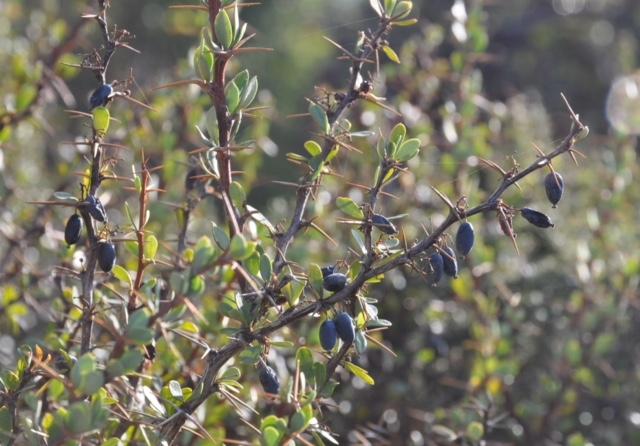
Berberis cretica
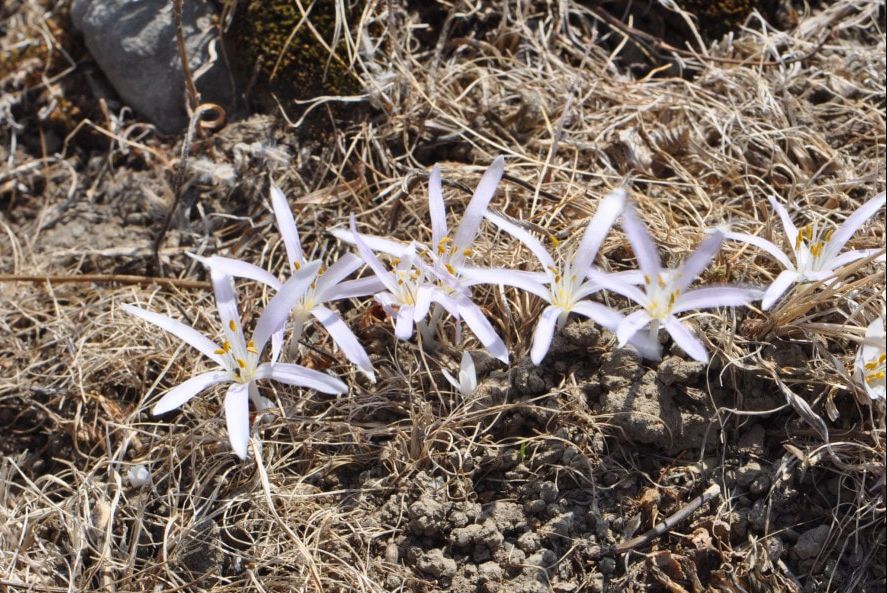
Colchicum pusillum
The next morning, we headed up to the start of the Gorge of Samaria in cloudy weather with a smattering of rain. We crossed our fingers that this was the catalyst for the autumn bulbs we had come to see. John Fielding, our Cretan expert and guide, showed us the rare endemic Zelkova abelica, growing in groups alongside the road. We turned back to explore a track leading up into the mountains. Several followed John to botanise, others diverged to see the southern coast view and the rest botanised along the road, finding the last few flowers of restharrow, Ononis spinosa, spiny mullein Verbascum spinosum and spiny chicory Cichorum spinosum, all of which have evolved to cope with constant grazing by the wild goats. Our first cyclamen of the trip, Cyclamen graecum ssp. candicum were starting into flower, with just a few of their dramatic leaves, with variations of silver, green and red markings, not all above ground yet. The species’ characteristic flower stalks, whose stem curls from the centre after pollination, was an added confirmation.
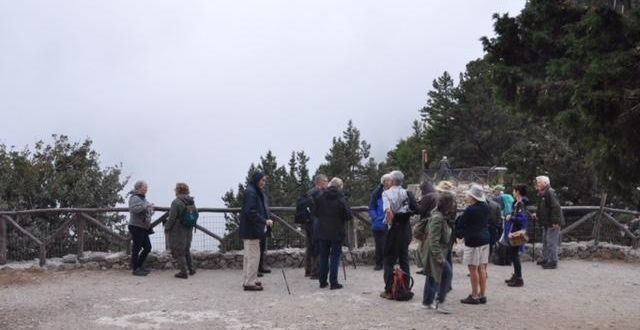
Head of the Samaria gorge
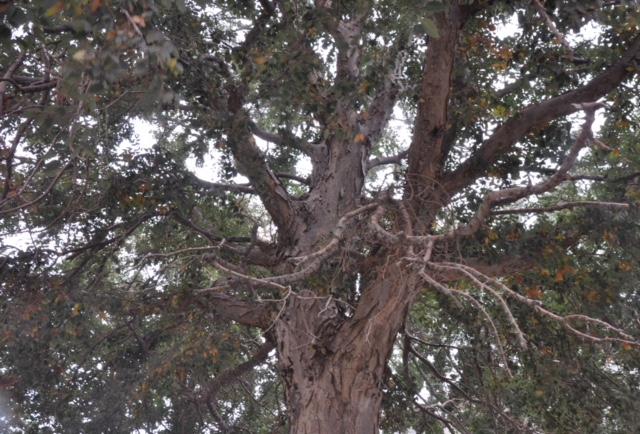
Zelkova abelica
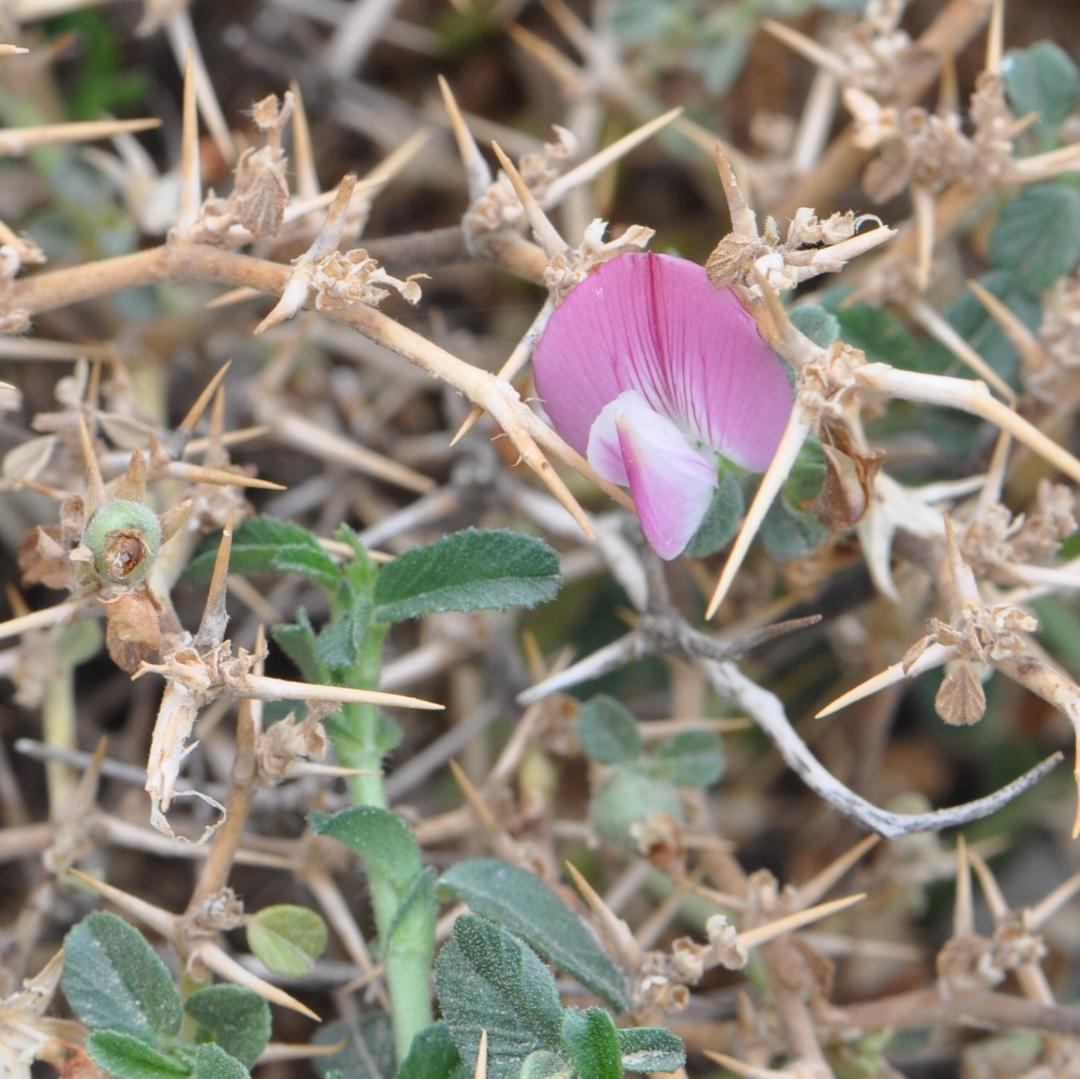
Ononis spinosa
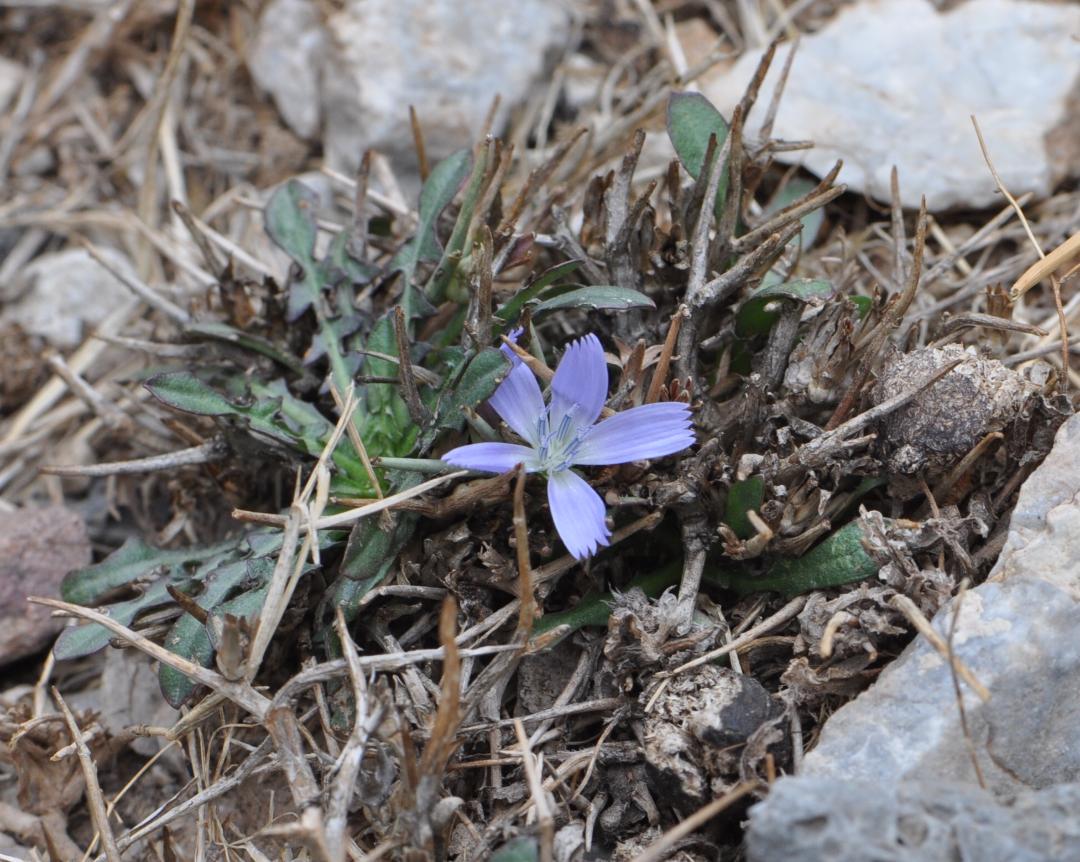
Spiny chicory
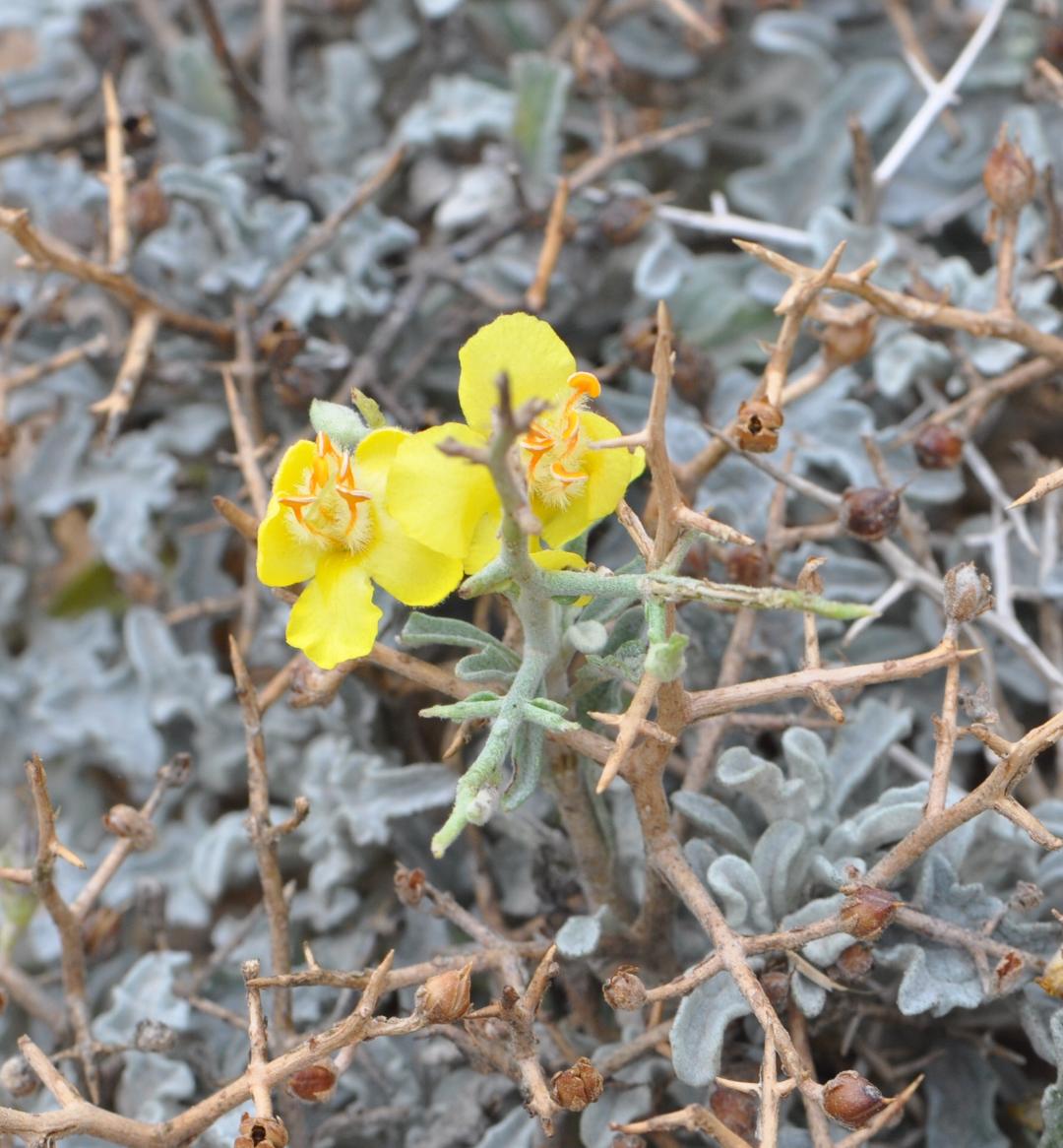
Verbascum spinosum
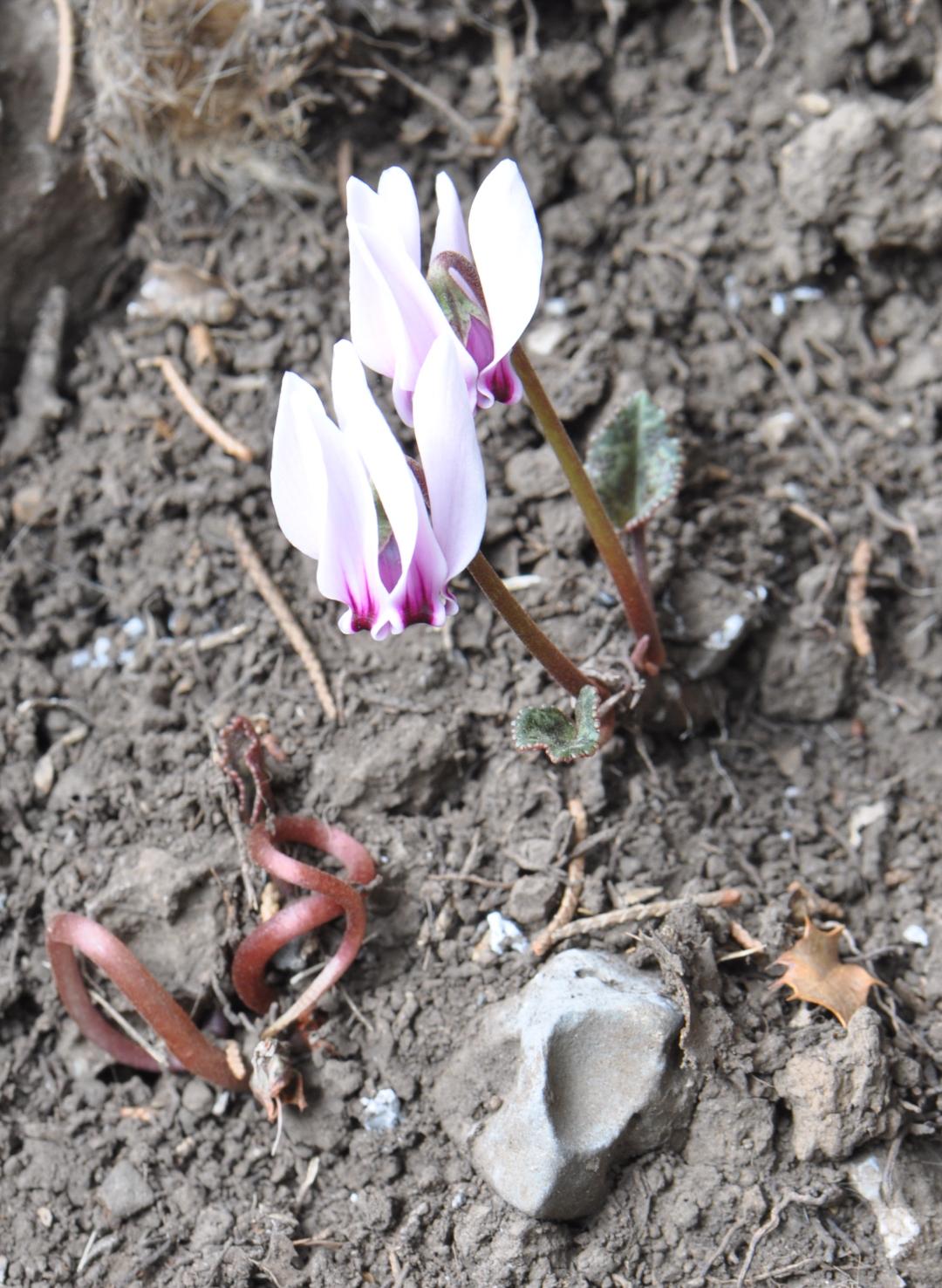
Cyclamen graecum ssp. candicum
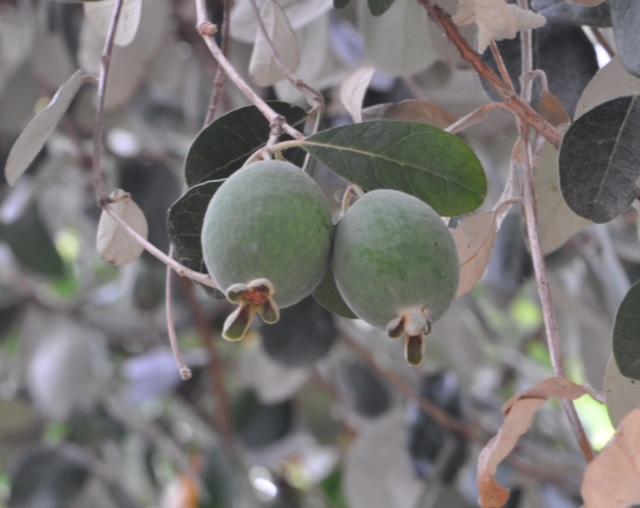
Acca sellowiana
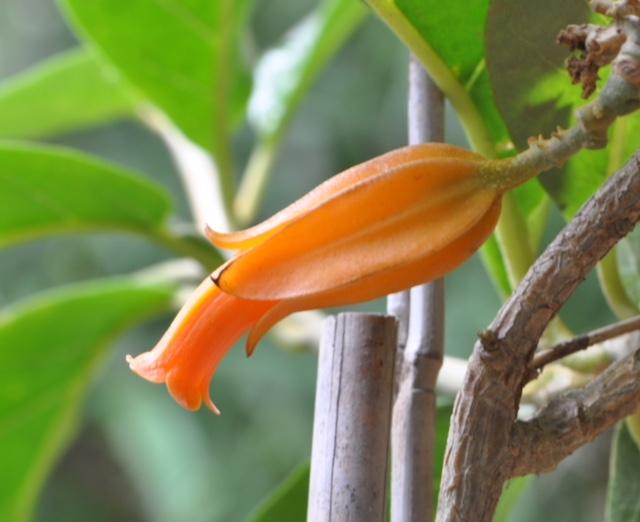
Gold finger shrub Juanulloa Mexicana
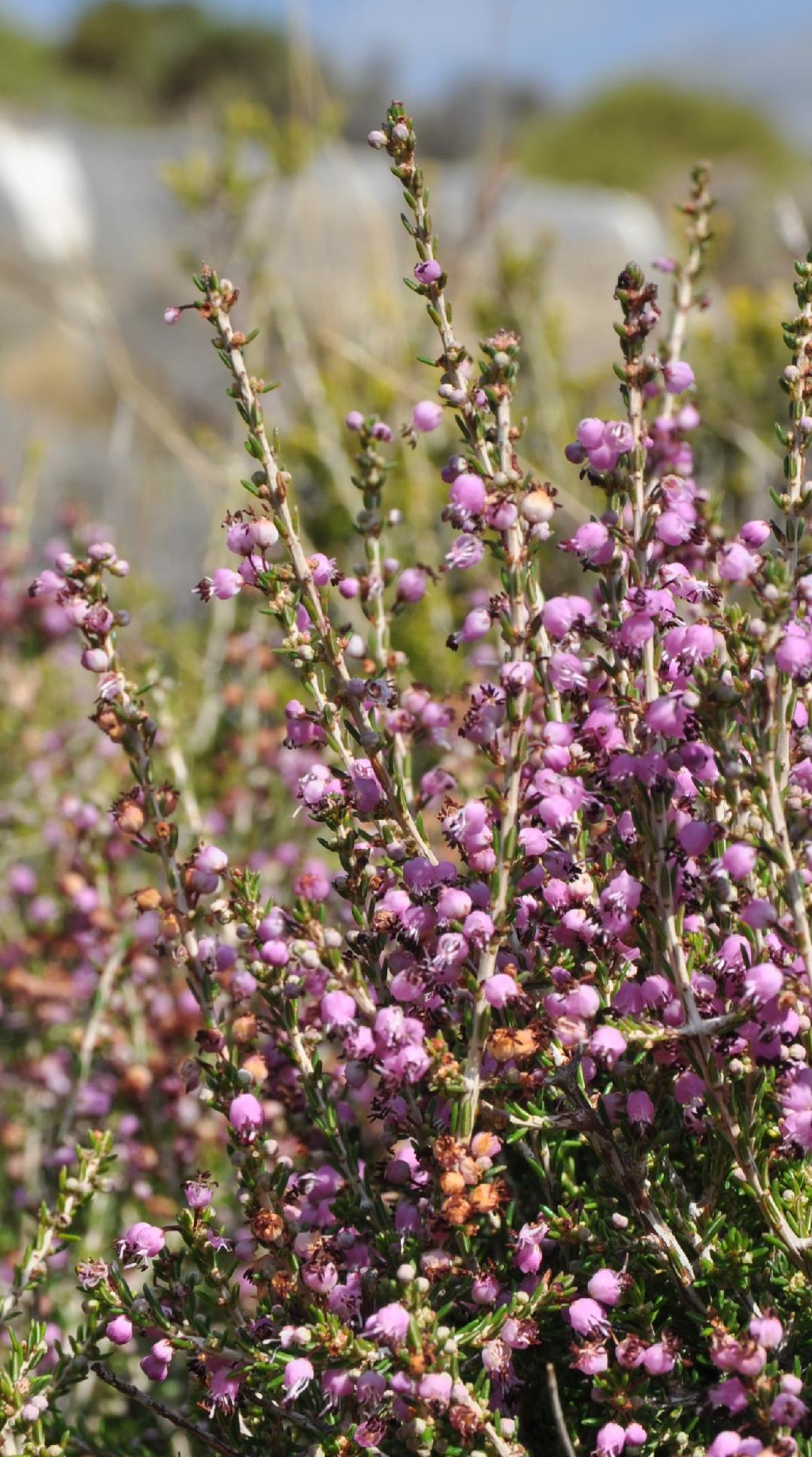
Erica manipuliflora
Another small tree species, Acer sempervirens was just beginning to turn colour. Descending to Fournes for lunch at the Botanic Park, we returned to a much warmer climate and the most eclectic of lunches. After delicious mushrooms, omelette and stuffed vegetables we were presented with plates of all sorts of berries from the exotic trees and shrubs growing in the fertile valleys below. Types of pineapple guava Acca sellowiana, persimmon, and a black fruit that tasted like a lychee were beautifully presented but sadly with no identification for diners of what we were eating.
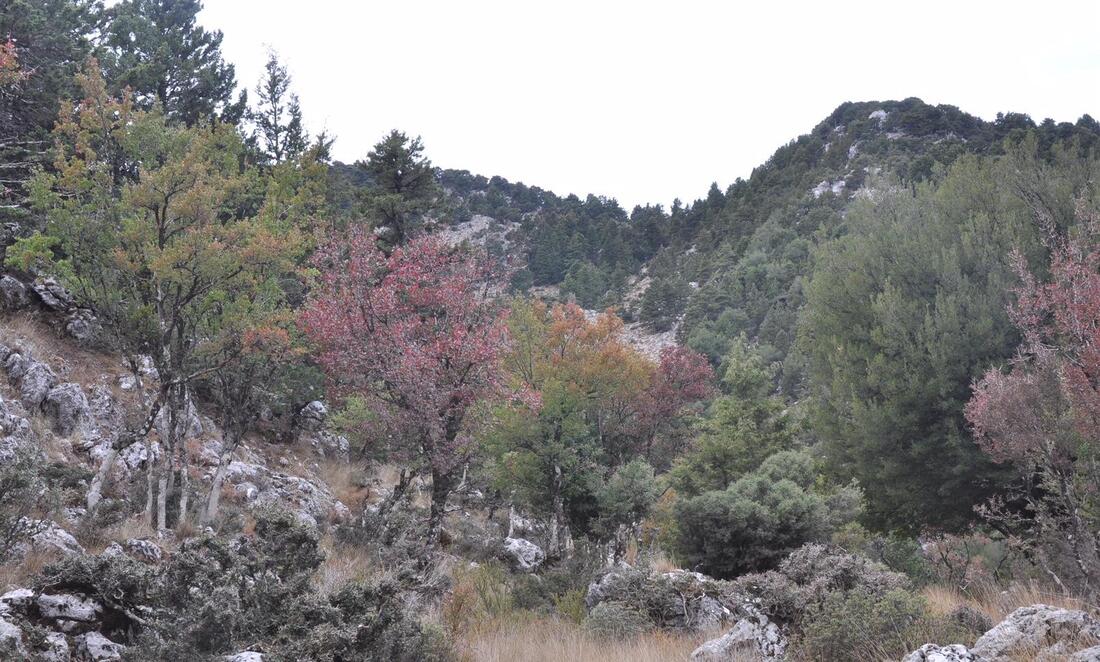
Acer sempervirens
A wonderfully named gold finger shrub, Juanulloa mexicana grew alongside the path, it is a member of the Solanaceae and said to flower almost continuously.
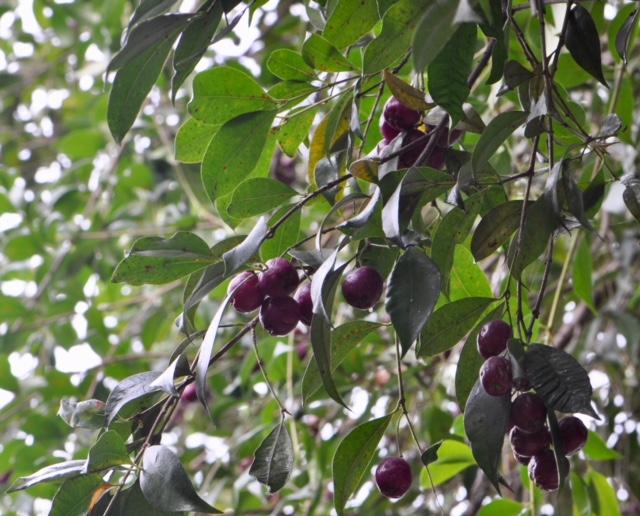
Syzgium oleosum (Lilly Pilly)
Day three took us on roads across a large area of acidic bedrock, covered in pink from the native heather, Erica manipuliflora, amongst oak scrub and the western strawberry tree Arbutus unedo. This is still a poorly botanised part of the island, the density of the vegetation suggesting it won’t be an easy task. We stopped at Koutsomados and Melvyn Jope showed us lovely drifts of Cyclamen hederifolium growing in deep leaf litter under planes and sweet chestnuts. At Topolia the tiny perfumed Narcissus elegans was flowering alongside plenty of Cyclamen confusum and the minute autumn squill, Prospero autumnalis. After a late lunch at the Diktina restaurant in Kolymbari, we headed east and then south to Plakias, our base for the rest of our stay.
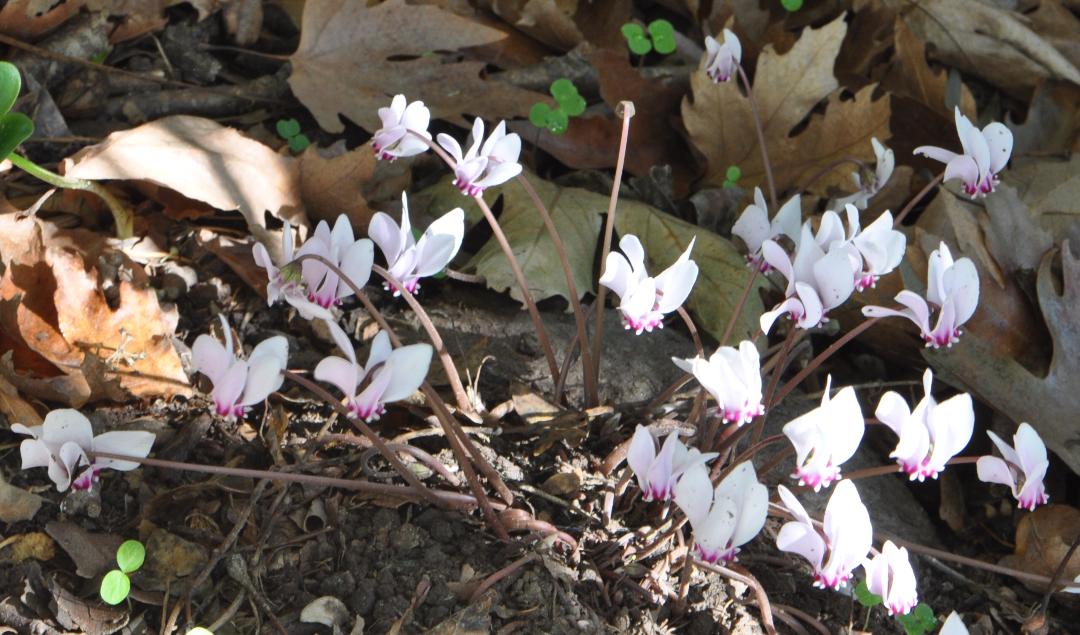
Cyclamen hederifolium
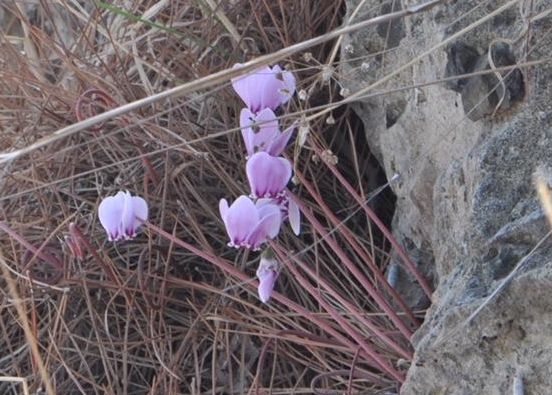
Cyclamen confusum
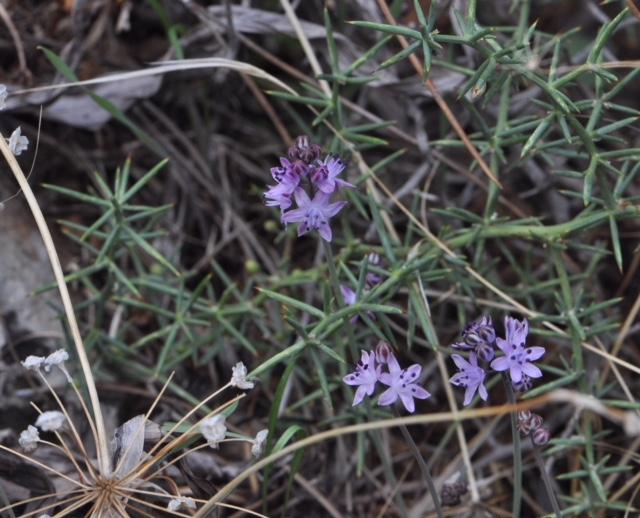
Prospero autumnalis
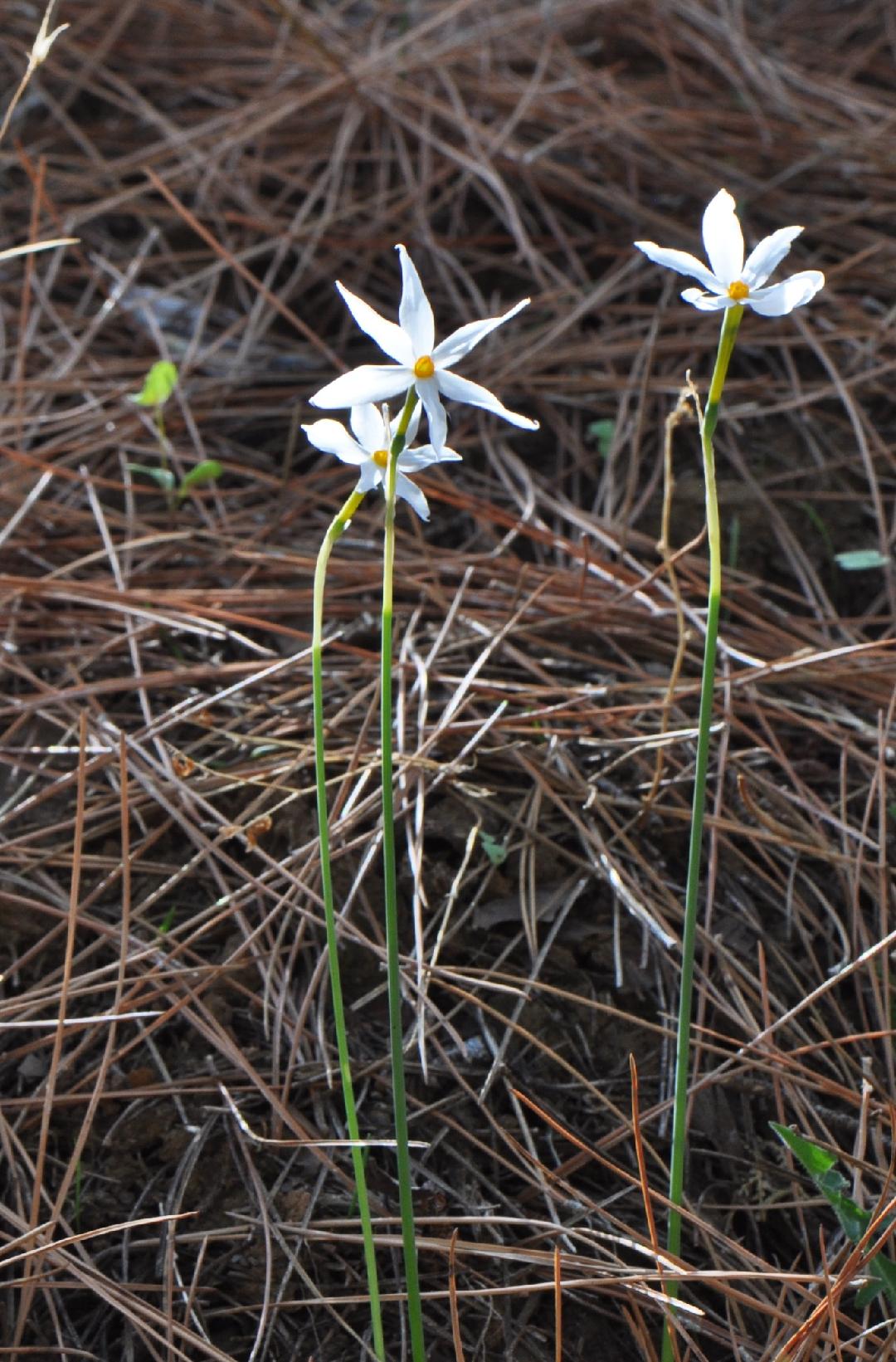
Narcissus elegans
Sunday morning brought us out of the town onto the beach, heading west towards the cliffs of the Kakomouri peninsula. The beautiful sea daffodils, Pancratimum maritimum were at peak display and it was stunning to see so many in flower at once. Walking on towards the cliff face, we came across bushes of Daphne gnidium and Thymelea hirsuta, along with Euphorbia paralias, all in flower.
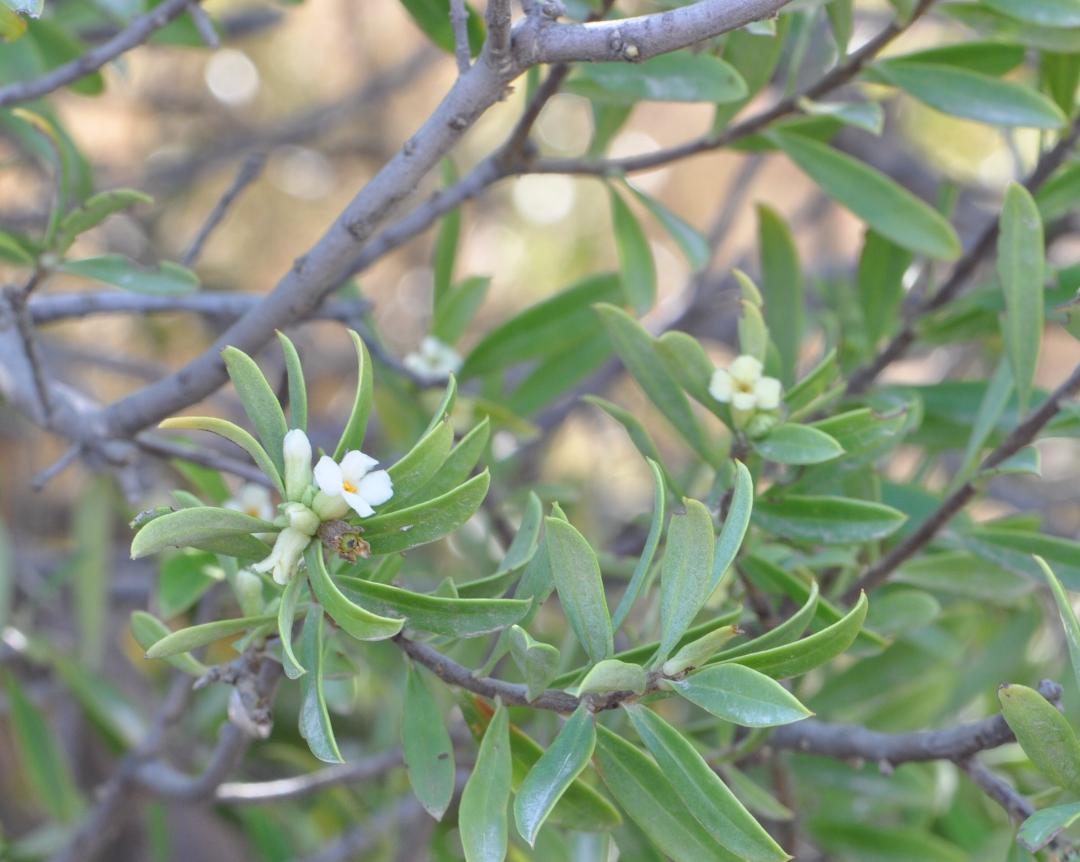
Daphne gnidioides
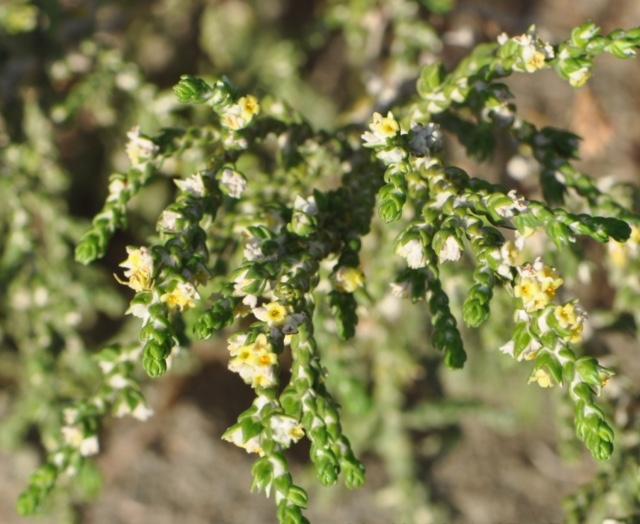
Thymelea hirsuta
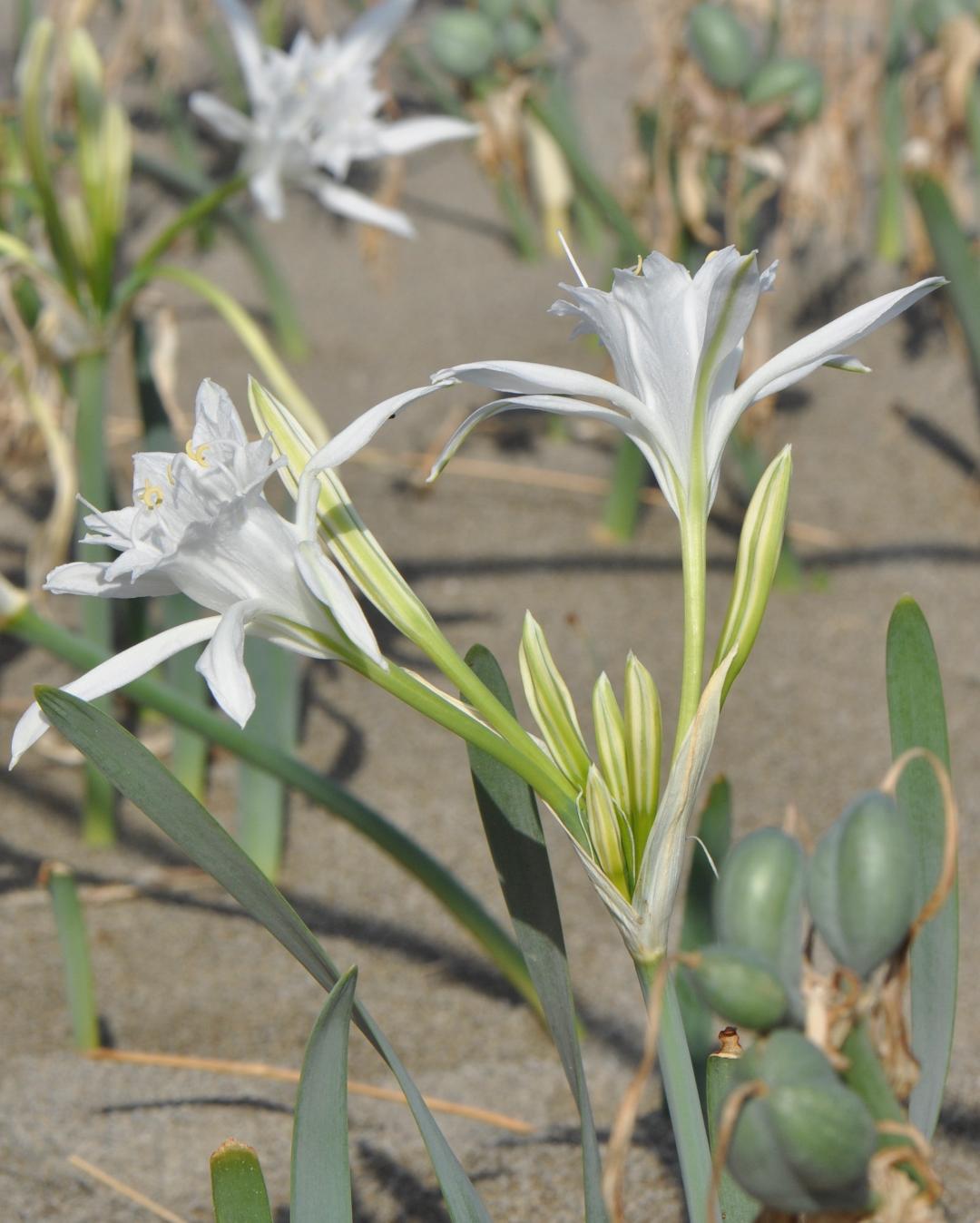
Pancratium maritimum
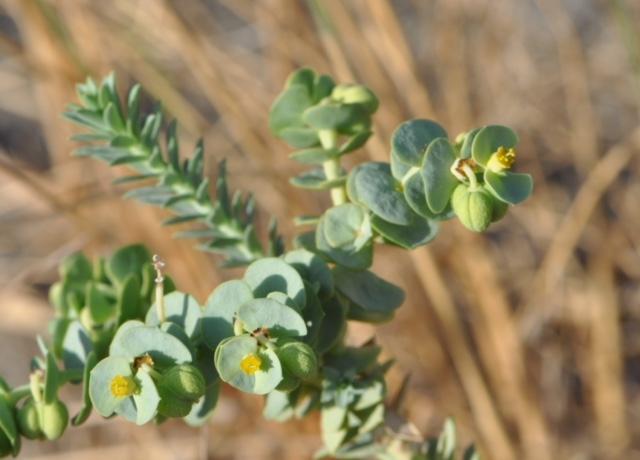
Euphorbia paralias
The cliff face had the distinctive purple veined leafy rosettes of the mandrake, Mandragora officinalis, but no flowers yet, while on the rock slopes above, vertical flower spikes stood out amongst the evergreen chasmophytes. The strong verticals were identified from one surviving whorl of yellow flowers as Lactuca acanthifolia. Walking over the saddle towards Damnoni, we came across more of the daphne, some already starting to show their red berries and spectacular views back down into Plakias. Over the brow, the unwelcome sight of fly-tipping met our eyes, smothering a small depression known for its autumn flowering crocus species and we noted huge palm trunks and plenty of building rubble. Despite everything, a seedling fan palm was emerging through the rubble, hopefully resistant to the red palm weevil which is decimating other species, in particular the Canary Island palms all over the Mediterranean.
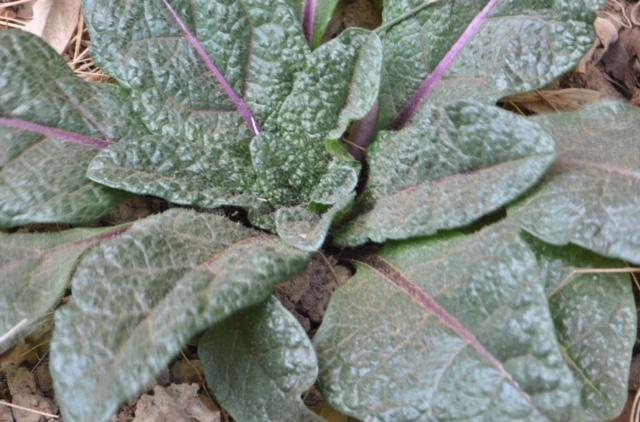
Mandragora officinalis
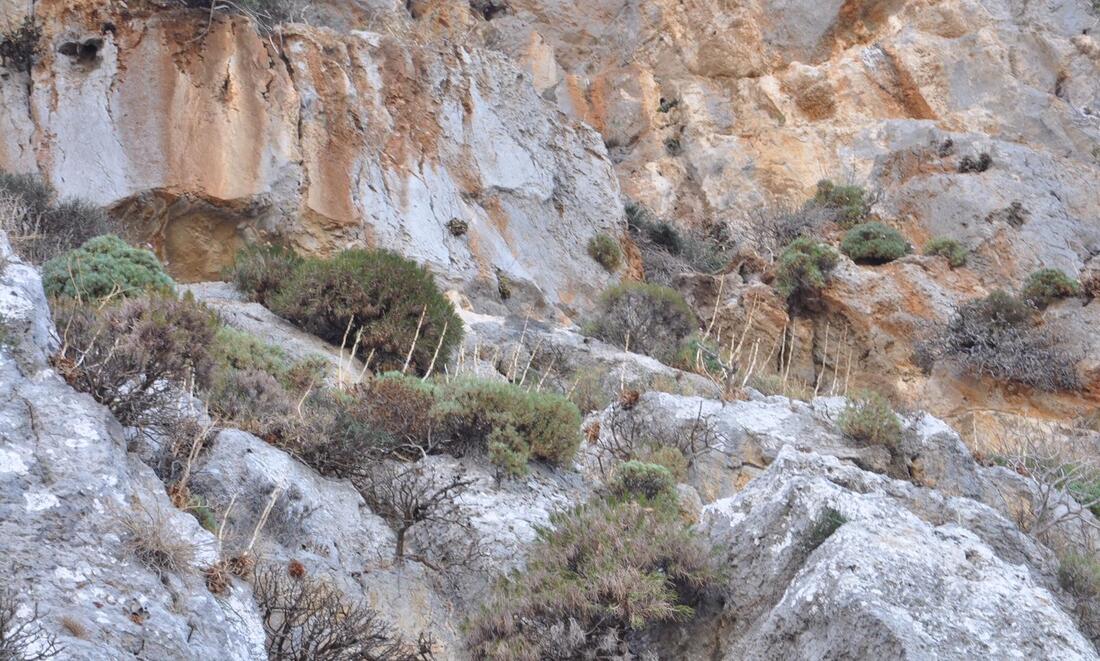
Lactuca spinosa
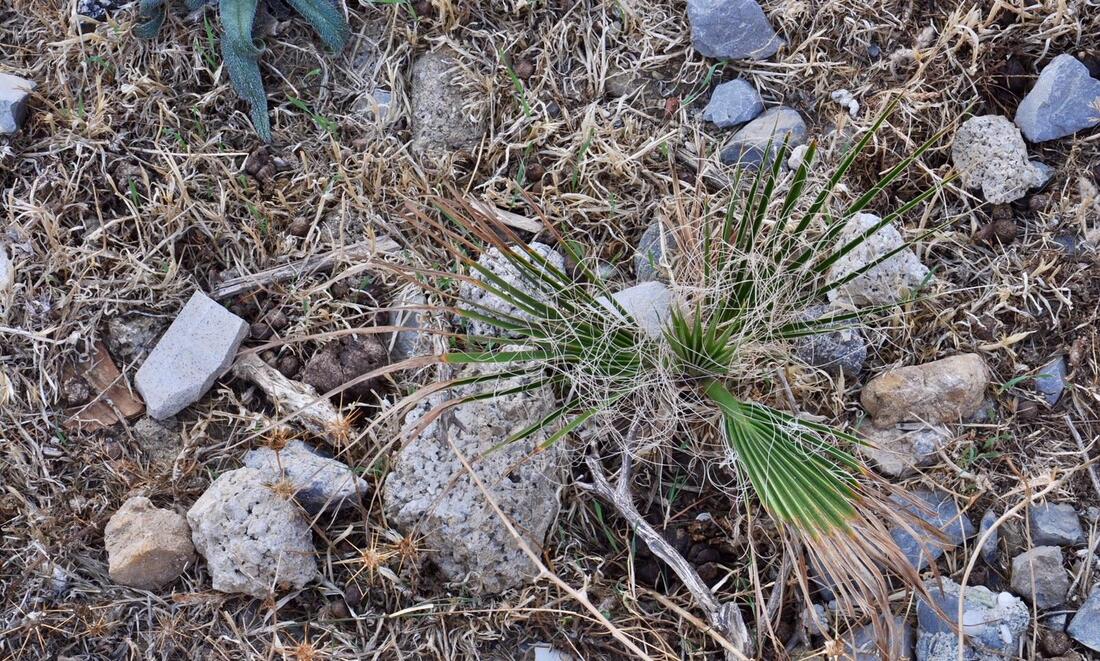
Seedling fan palm
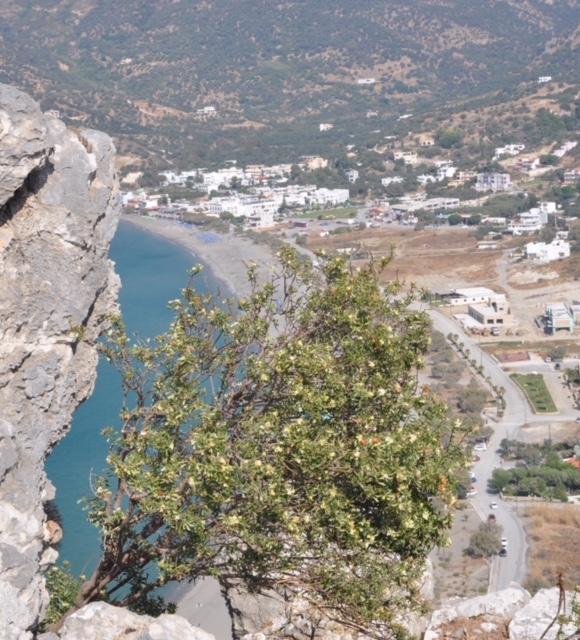
Daphne gnidium overlooking Plakias
After an extravagantly long lunch we drove on to a very early religious site with huge plane trees, Platanus orientalis down by the streamside. The track down had many storax, Styrax officinalis in fruit as well as a series of ancient rock tombs cut into the cliffs on our left. The prettily decorated church of the Five Holy Virgins was open to visitors and then we reached the quiet and very atmospheric shade of the big plane trees. We went on to Argyropolou, the town whose constant waterfalls make it a popular tourist spot, especially during the summertime. There were plenty of barbel swimming in tanks alongside the tavernas and cats everywhere one looked.
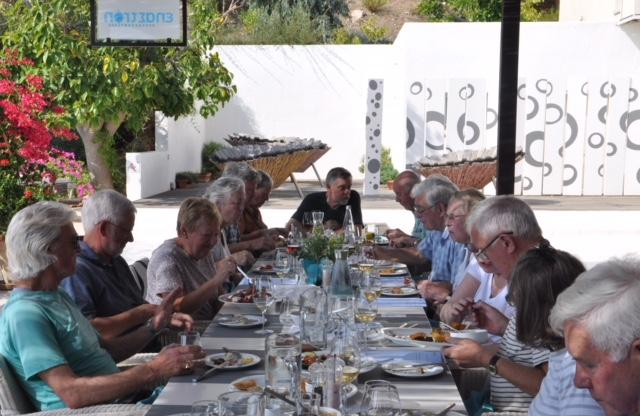
Extravagantly long lunch
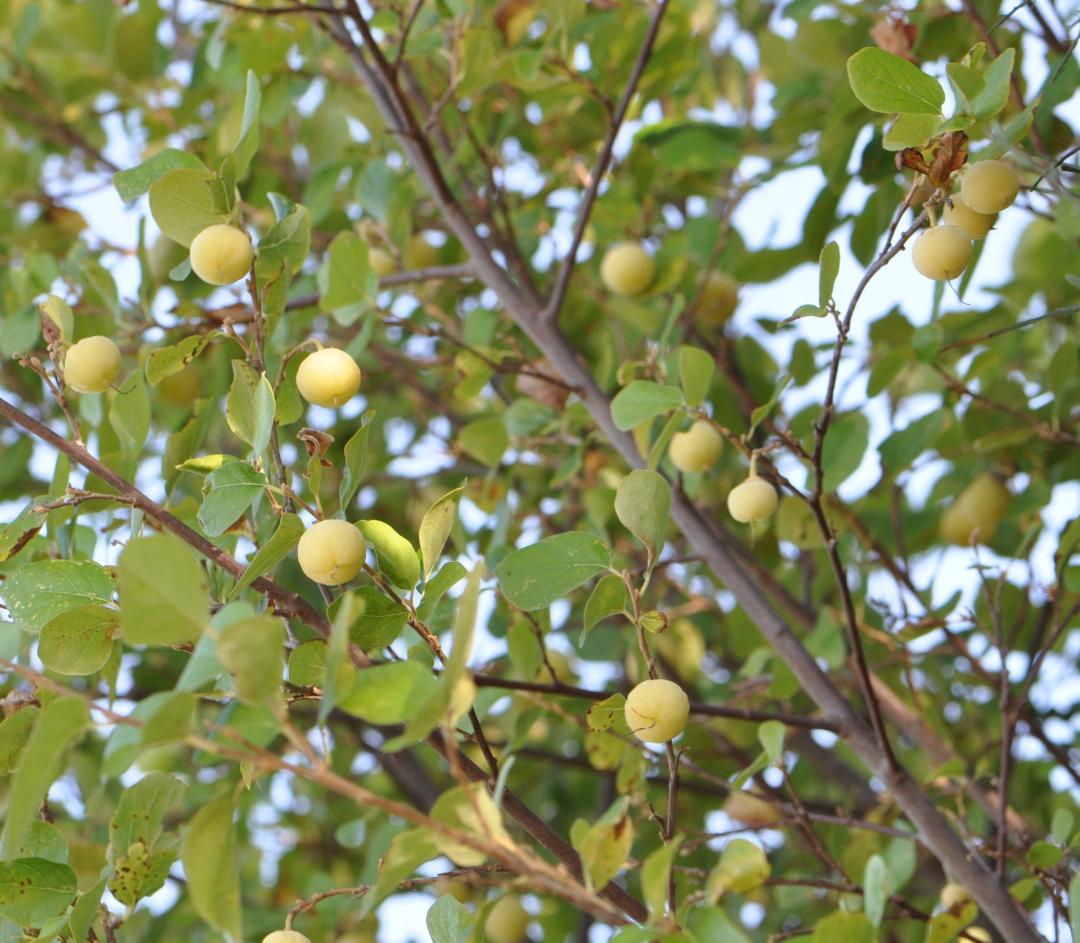
Styrax officinalis
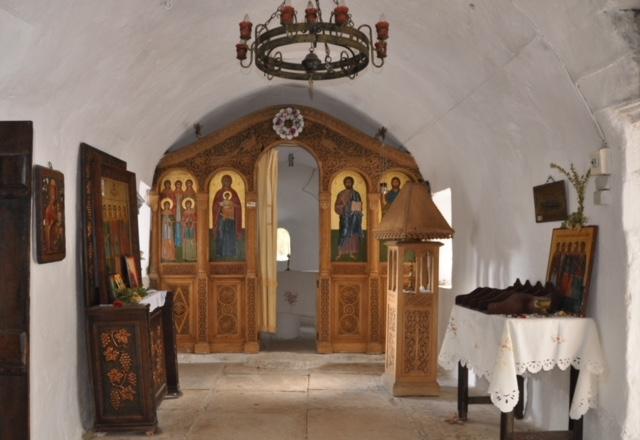
Church of the Five Holy Virgins
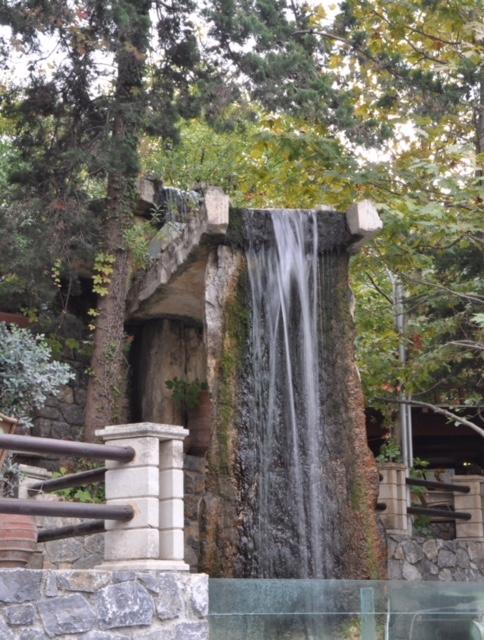
Argyroupoli waterfalls
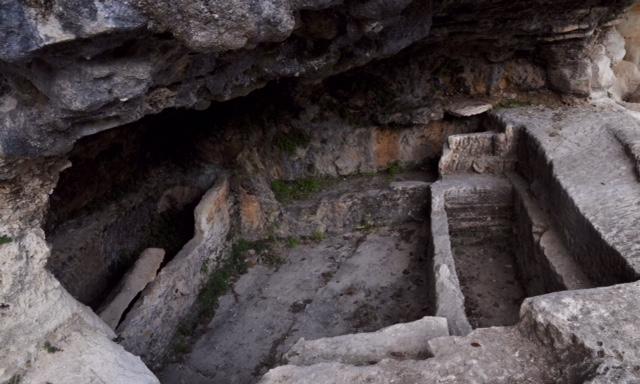
Ancient rock tombs
Monday saw us driving towards Spili, turning off towards the Gious Kambos plain heading for the little church amongst the famous Spili bumps. Along the track were isolated specimens of autumn ladies’ tresses Spiranthes spiralis and Allium chamaespathum, the latter very discrete with its green and white colouring. Plentiful water from the spring meant that there were still flowers on the Cirsium creticum attracting bees as well as butterflies. The rock face behind was the site for Allium callimischon ssp. haemostictum and those who ventured up on the ridge were rewarded with the first sighting on this tour of Sternbergia sicula. Sadly the Colchicum macrophyllum John had reconnoitred the week before were past their best. Others searched for further north, were not showing above ground yet in this dry autumn.
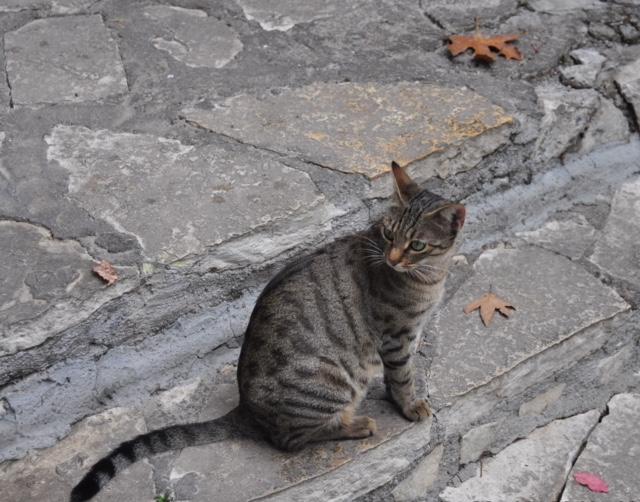
Cretan cat
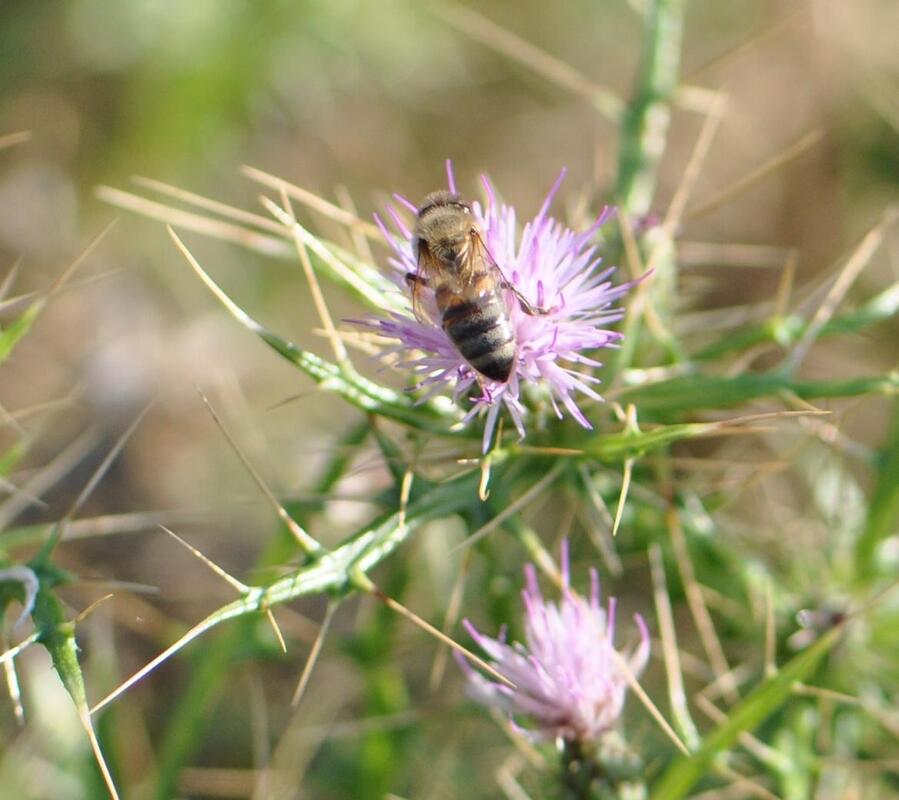
Cirsium creticum
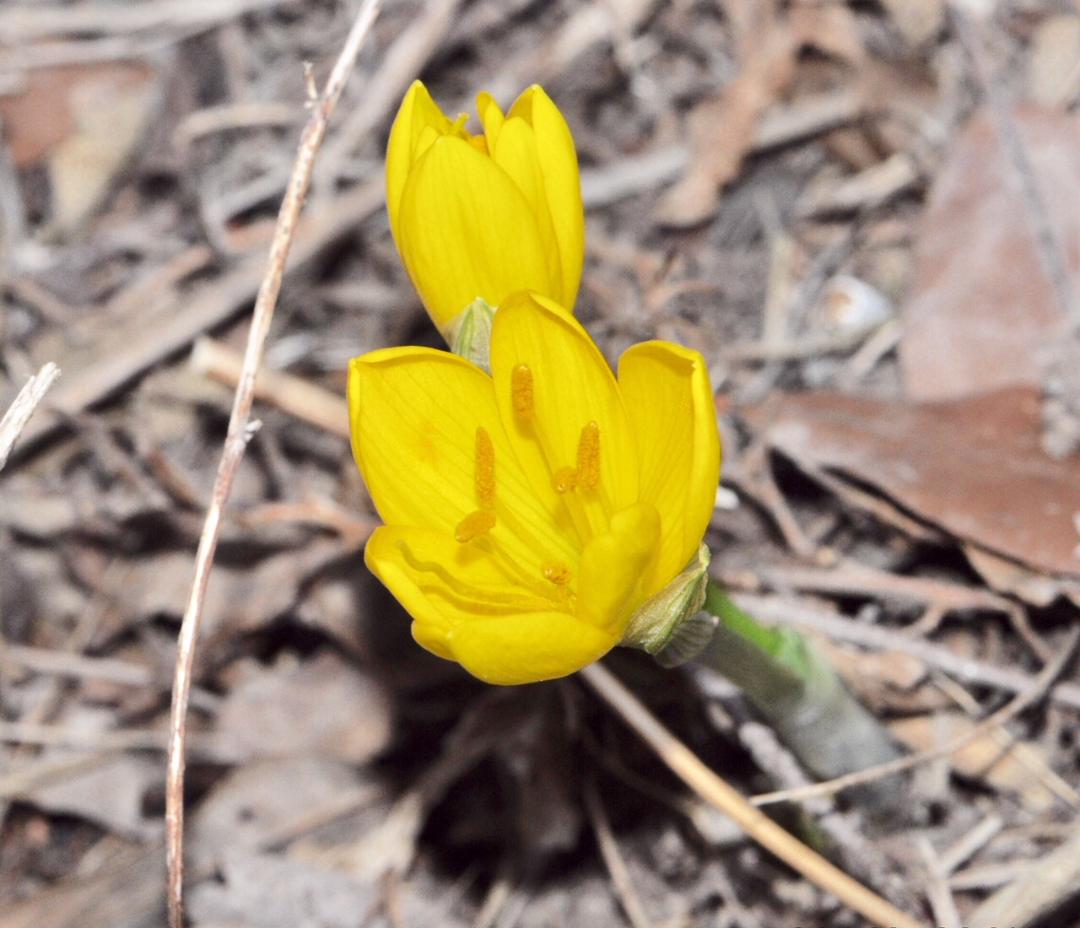
Sternbergia sicula
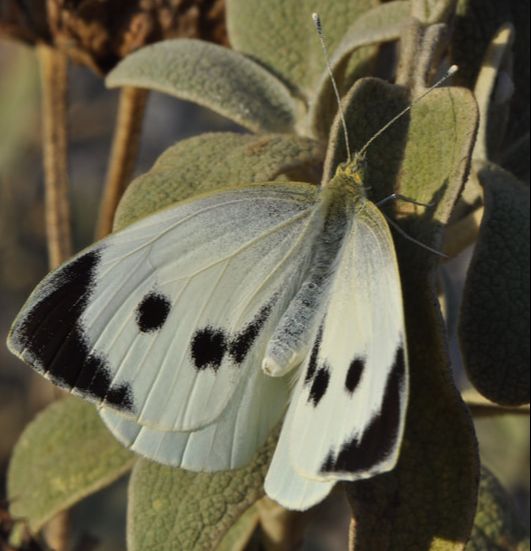
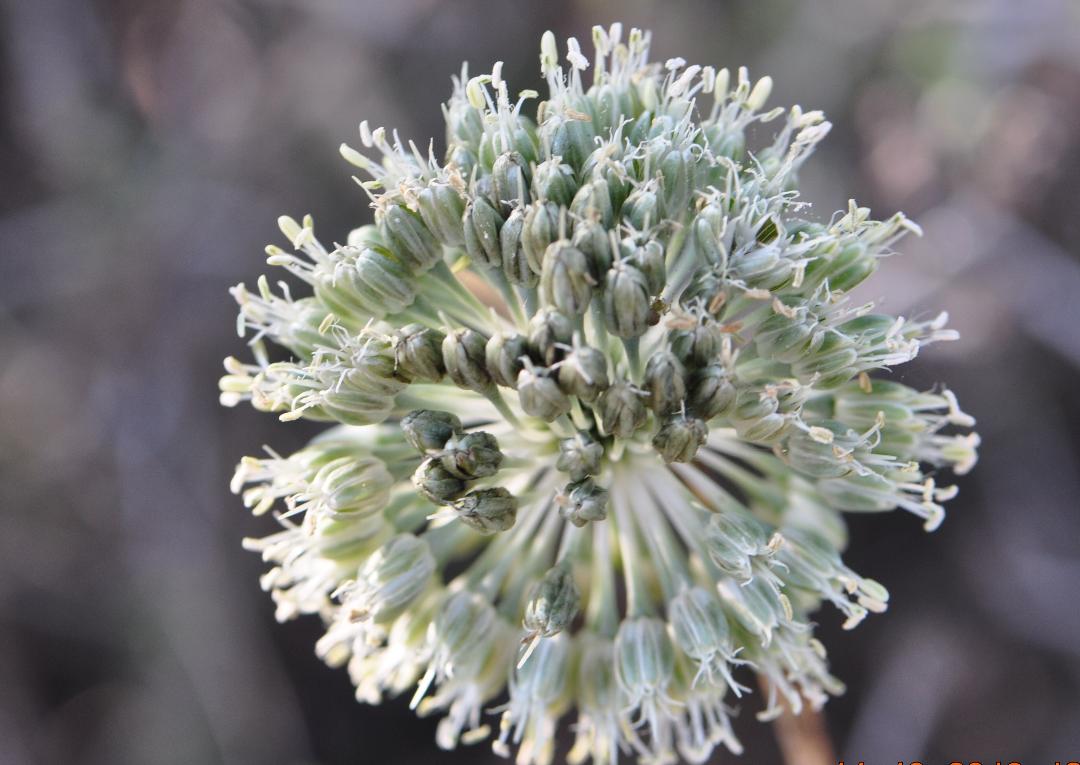
Allium chamaespathum in flower
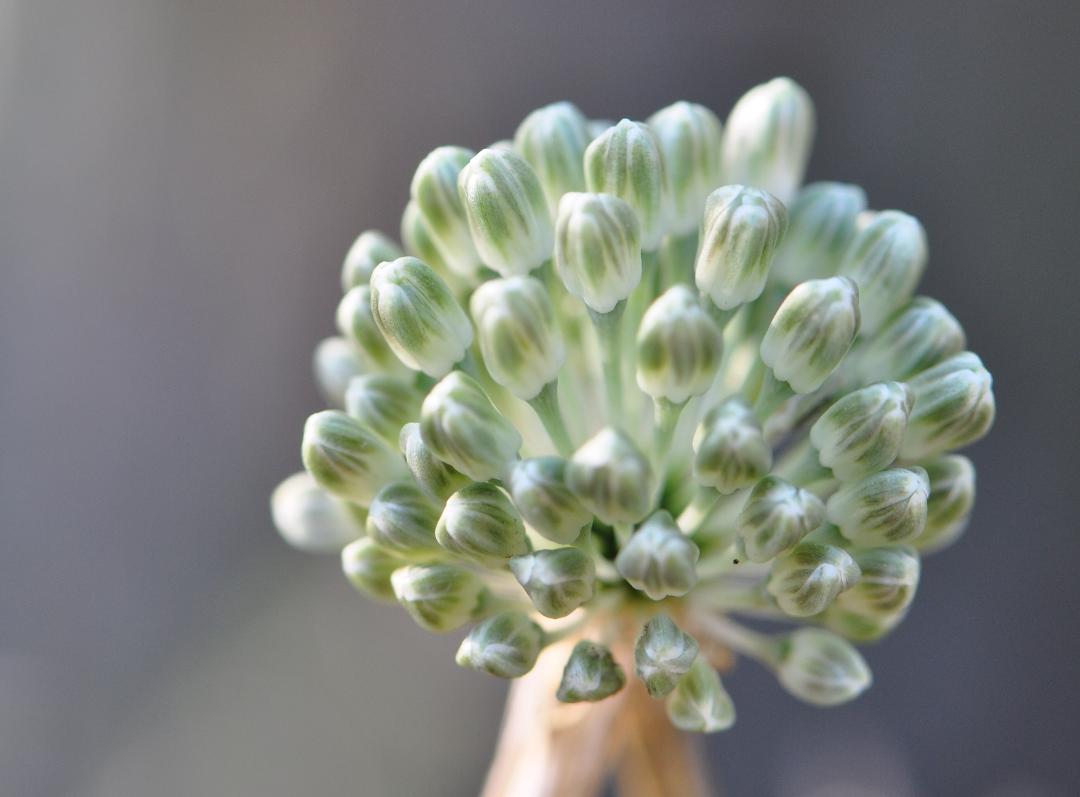
Allium chamaespathum in bud
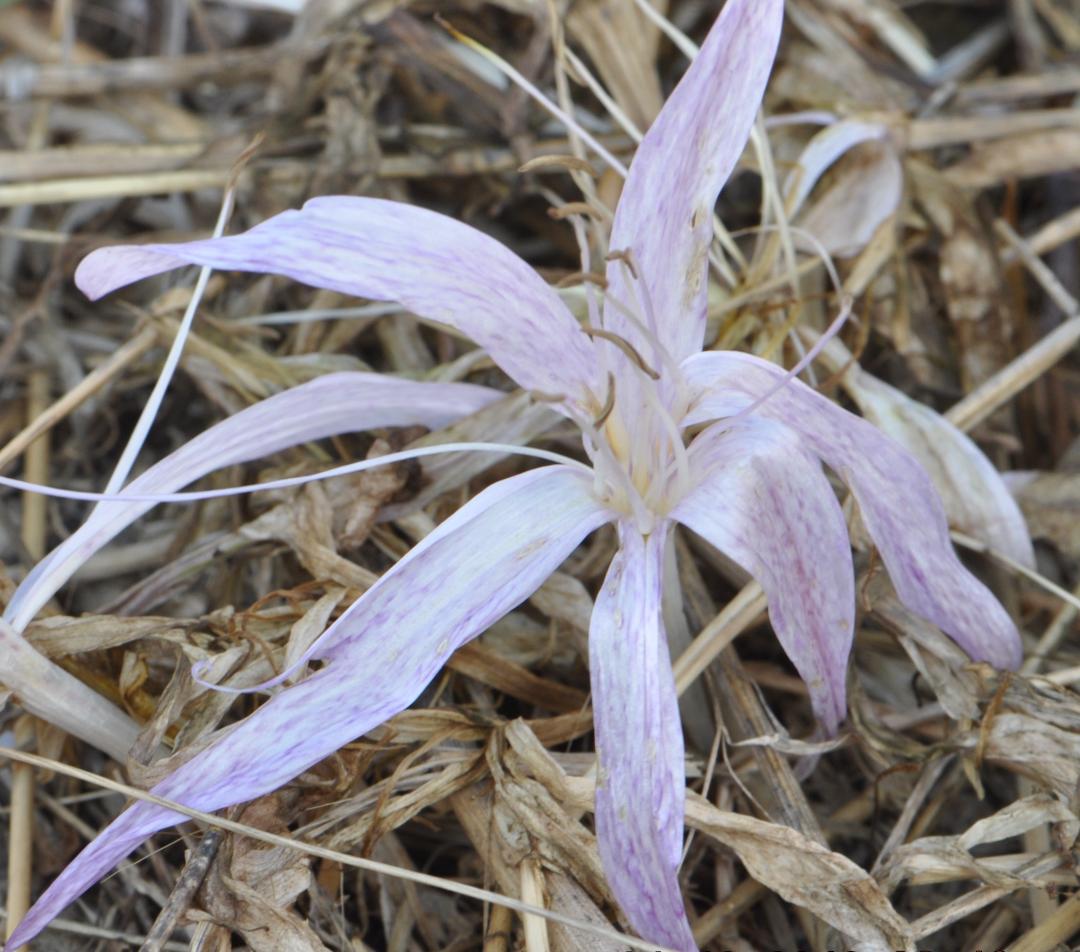
Colchicum macrophyllum
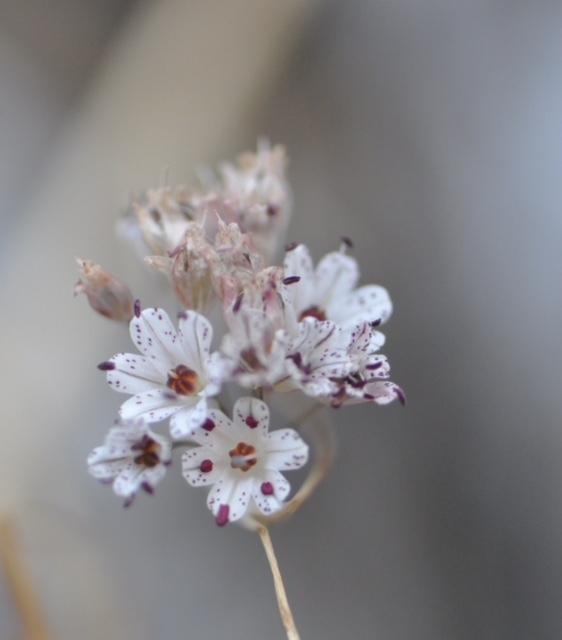
Allium callimischon ssp Haemostictum
We lunched at Thronos in the Aravanes Taverna, with a fine view, then travelled on to the Arkadi Monastery, a site of major historical and religious importance to Cretans in their fight for independence from Ottoman rule. The majority of us chose to visit this huge rectangular set of buildings with an early church at its centre. Euphorbia peplis was spotted growing in the courtyard. To the west, the ground drops sharply into a gorge but a few followed a track northwards up to a small church amongst woodland on the skyline.
This scrub woodland appeared ungrazed. We did find goats up at the church, however, and a scattering of a little autumn flowering dandelion, Taraxacum, sp. in the field behind. It was a good year for acorns on the kermes oaks, Quercus coccifera but there was little sign of the bright scarlet galls which are the source of the ancient kermes red dye.
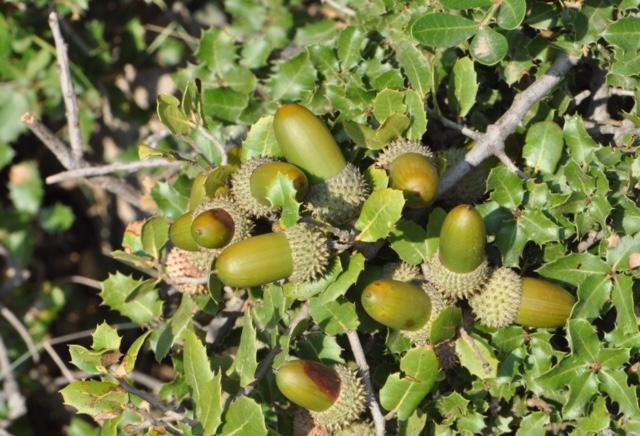
Quercus coccifera
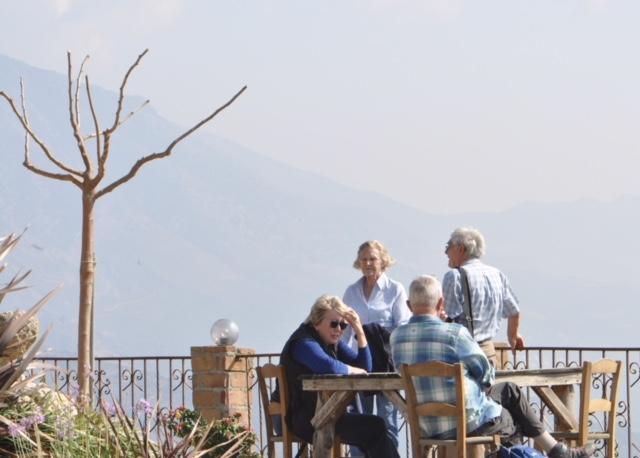
L to R: Juliet Walker, Jeanette Brickell, Melvyn Jope, and Chris Brickell, at the Aravanes Taverna, Thronos
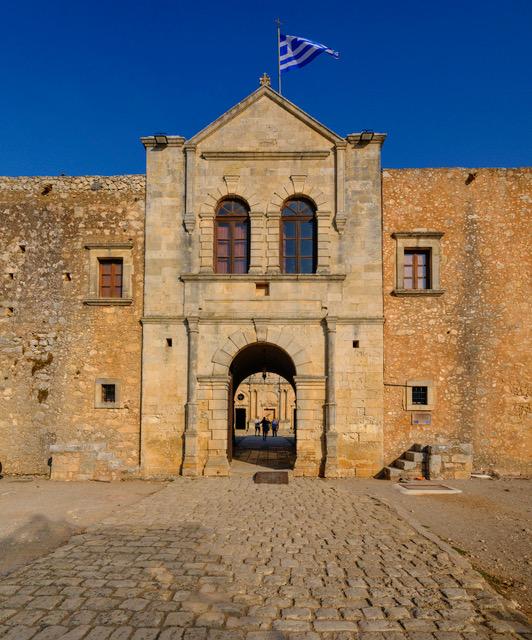
Arkadi Monastery
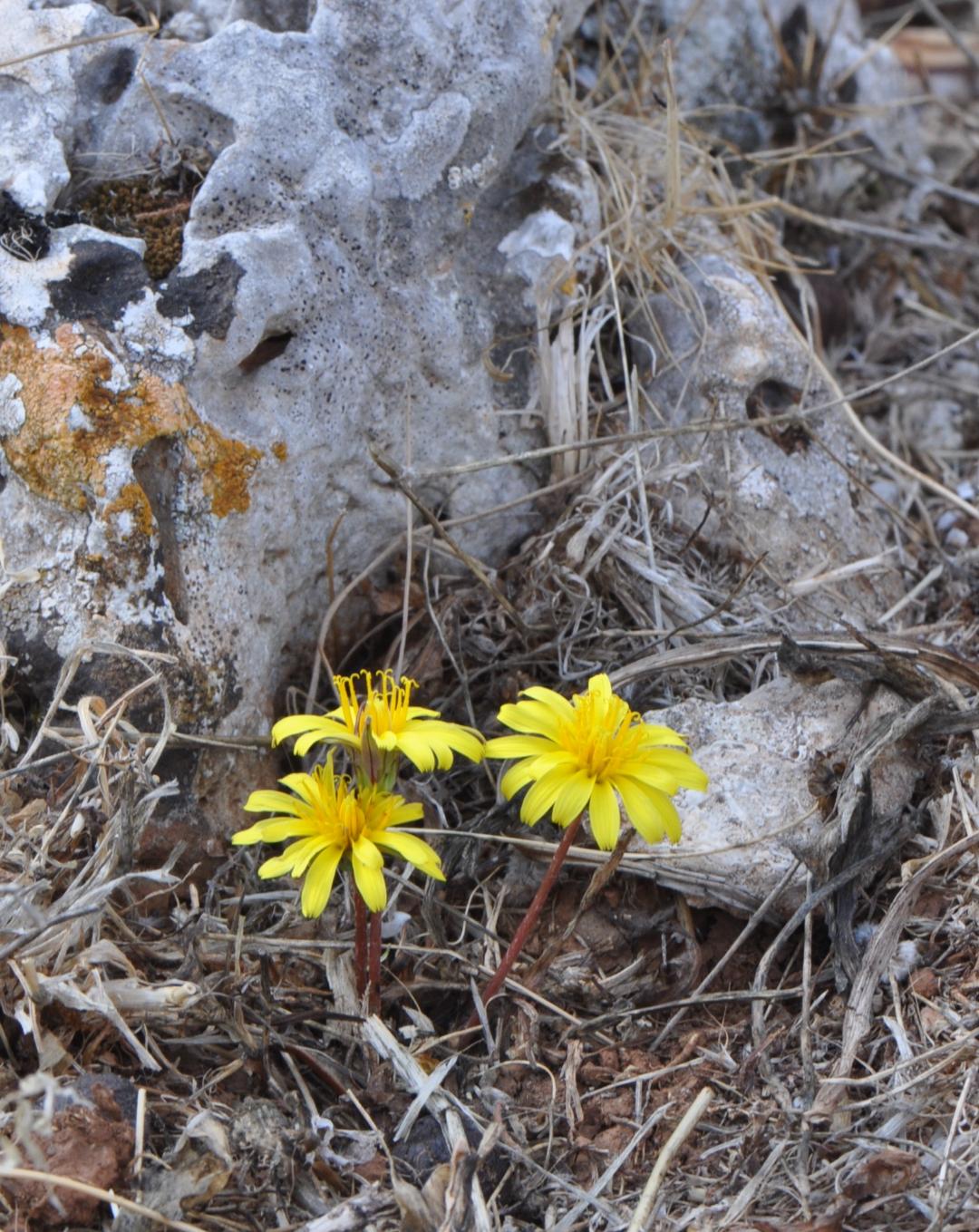
Taraxacum sp.
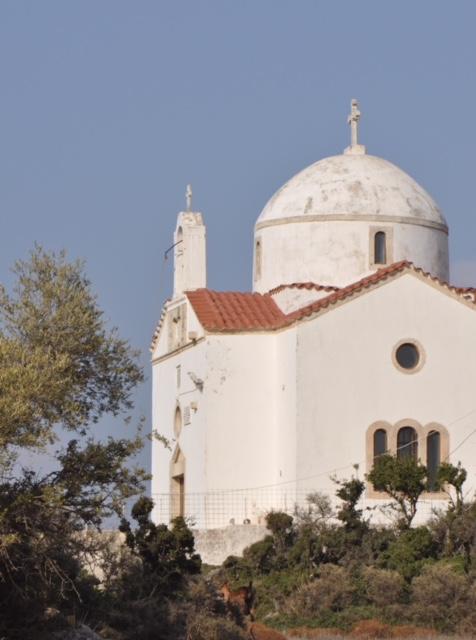
We stayed local on 22 October, driving up to Myrthios, a pretty village high up above Plakias with excellent views of the Libyan sea. The bus driver declined to use the precipitous road below so most of us walked down to the track below the village. This led to a wet seep, full of Typha domingensis, the native reedmace and other native plants such as Myrtus communis and Clematis cirrhosa, the latter just starting into flower. The yellow aromatic inula, Dittrichia viscosa the predominant flowering plant in the autumn landscape so far, was in peak condition. One tall herb, with tiny white composite flowers turned out to be an introduced weed, Symphyotrichum squamatumor. At the end of the track we found old olive trees with enormous trunks and many Cyclamen graecum ssp. candicum starting into bloom. The site had a good range of forms and colours and the Cyclamen experts compared notes on the more unusual ones.
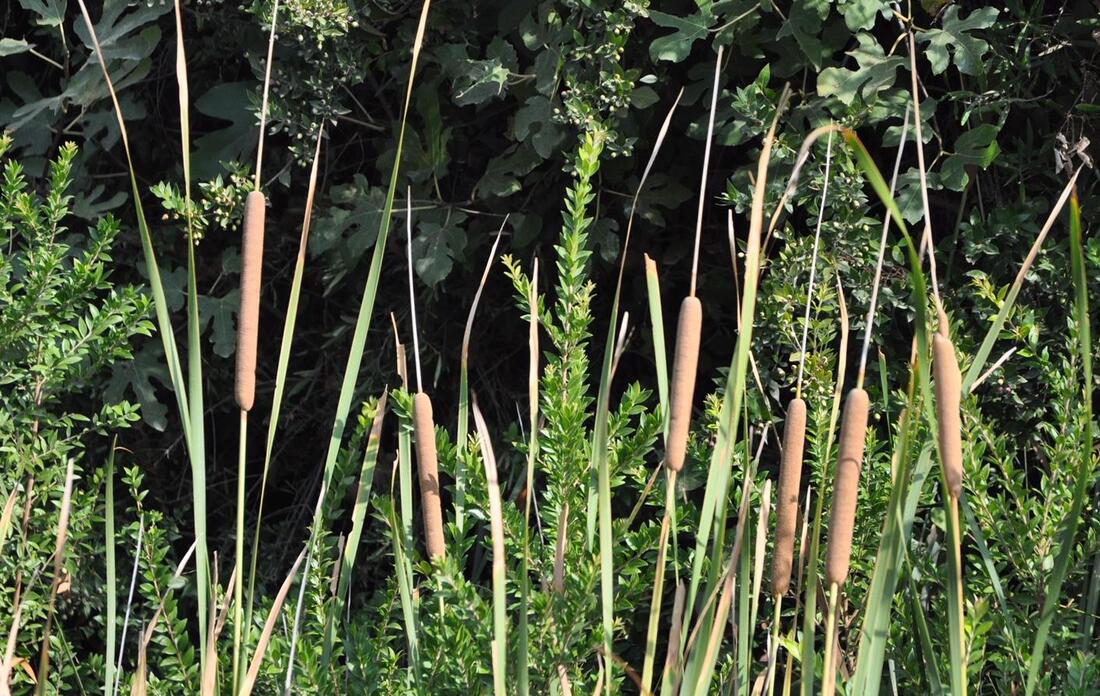
Typha domingensis
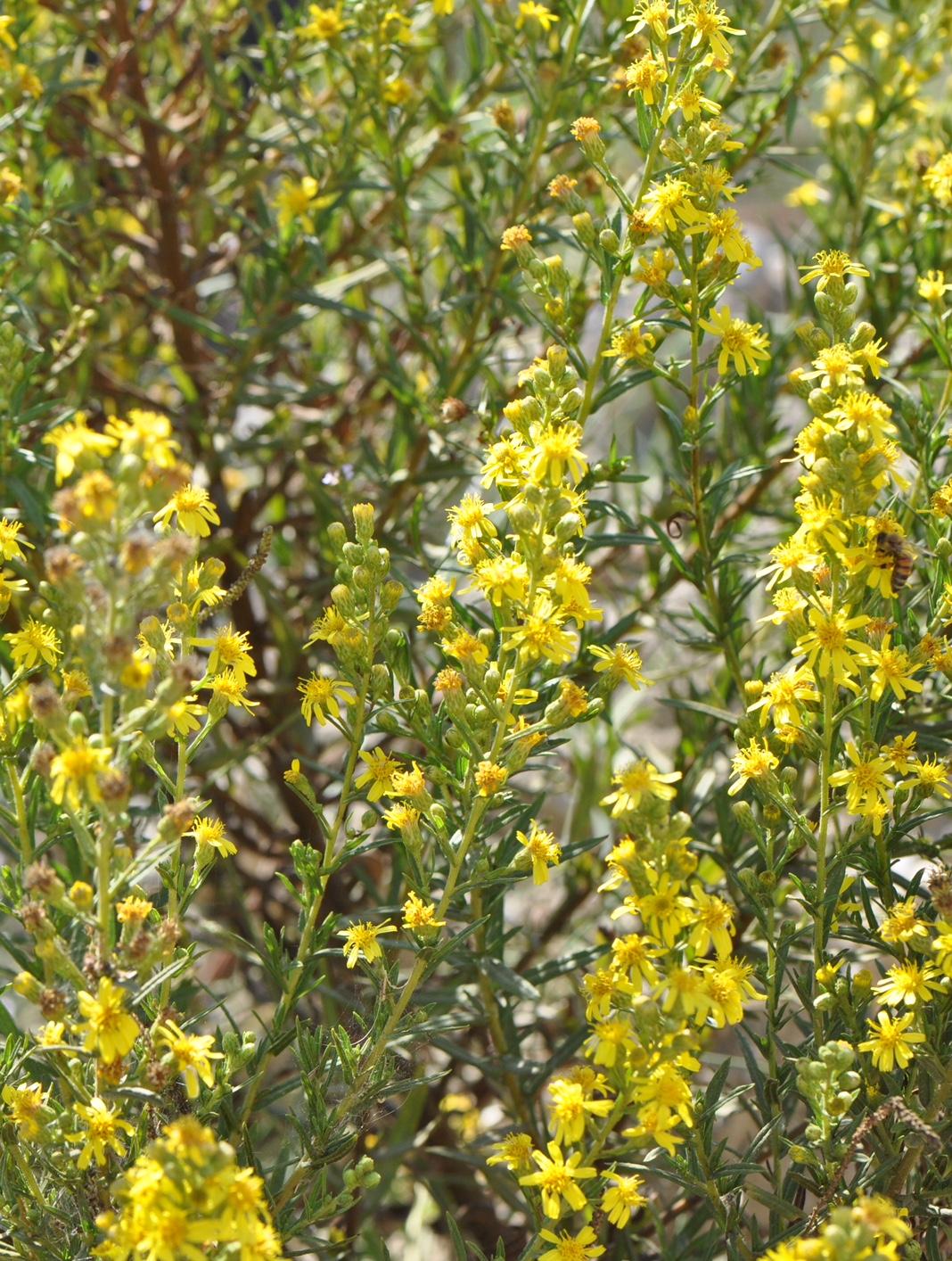
Dittrichia viscosa
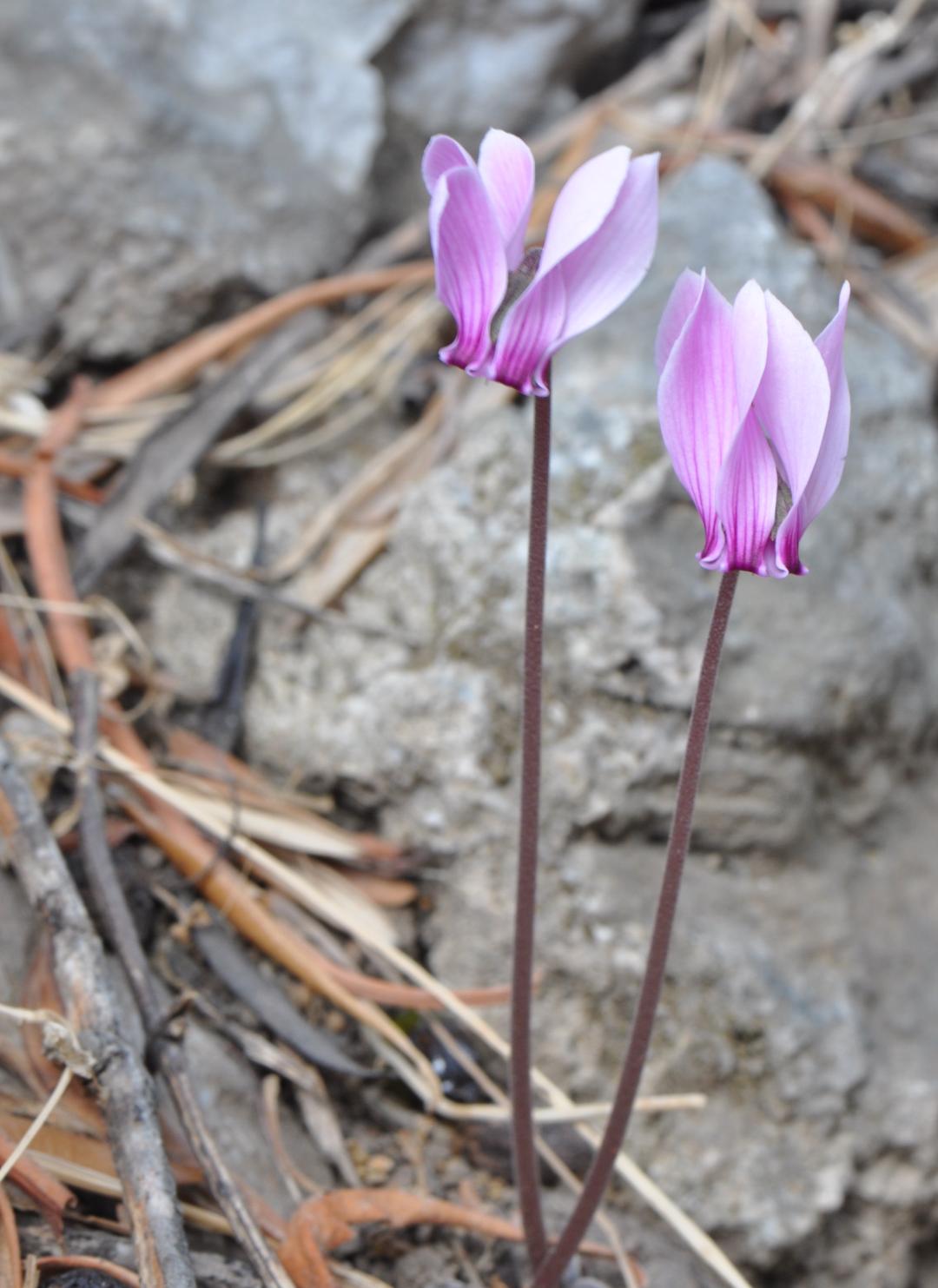
Cyclamen graecum
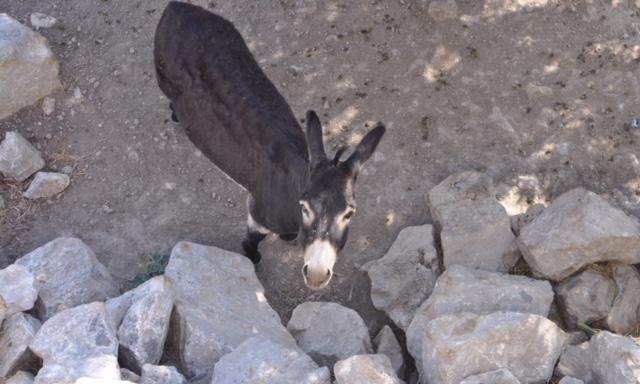
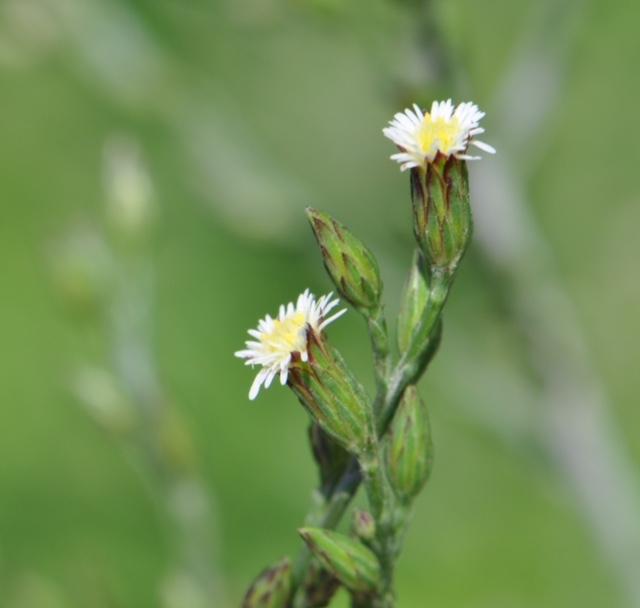
Canadian fleabane
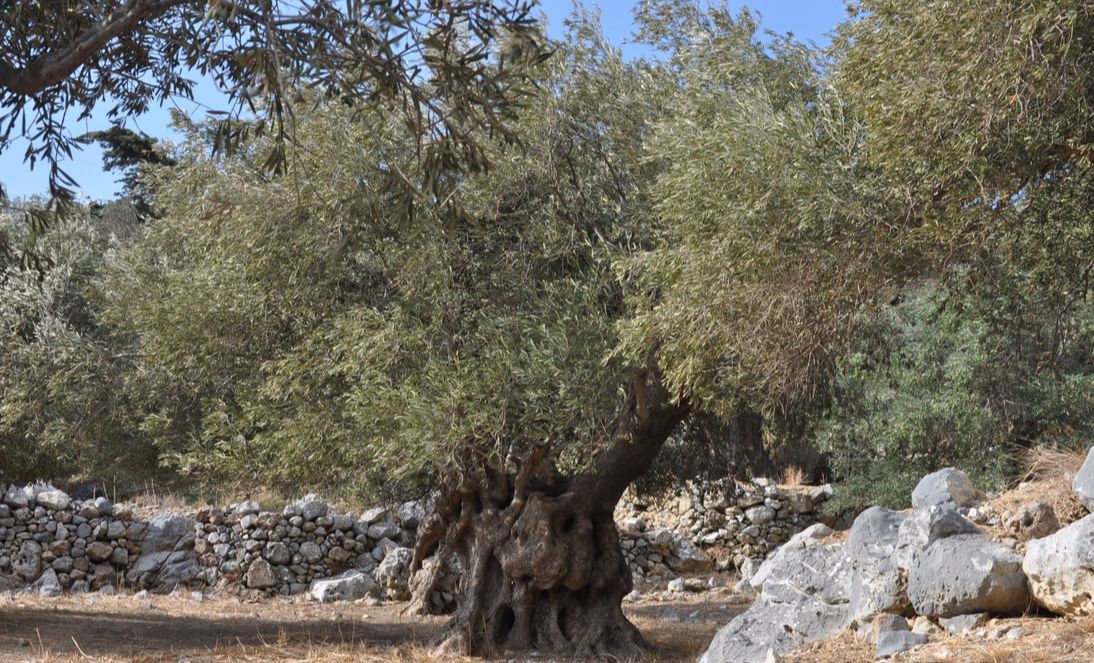
Ancient olive tree
After a long pull back up we enjoyed a welcome lunch and a charming encounter with the resident donkey below.
Driving back down the Kotsifou Gorge, Sternbergia sicula was flowering along the roadsides, with plenty of chasmophytes, such as Linum arboretum and Staehelina arborea in fruit on the rock walls.
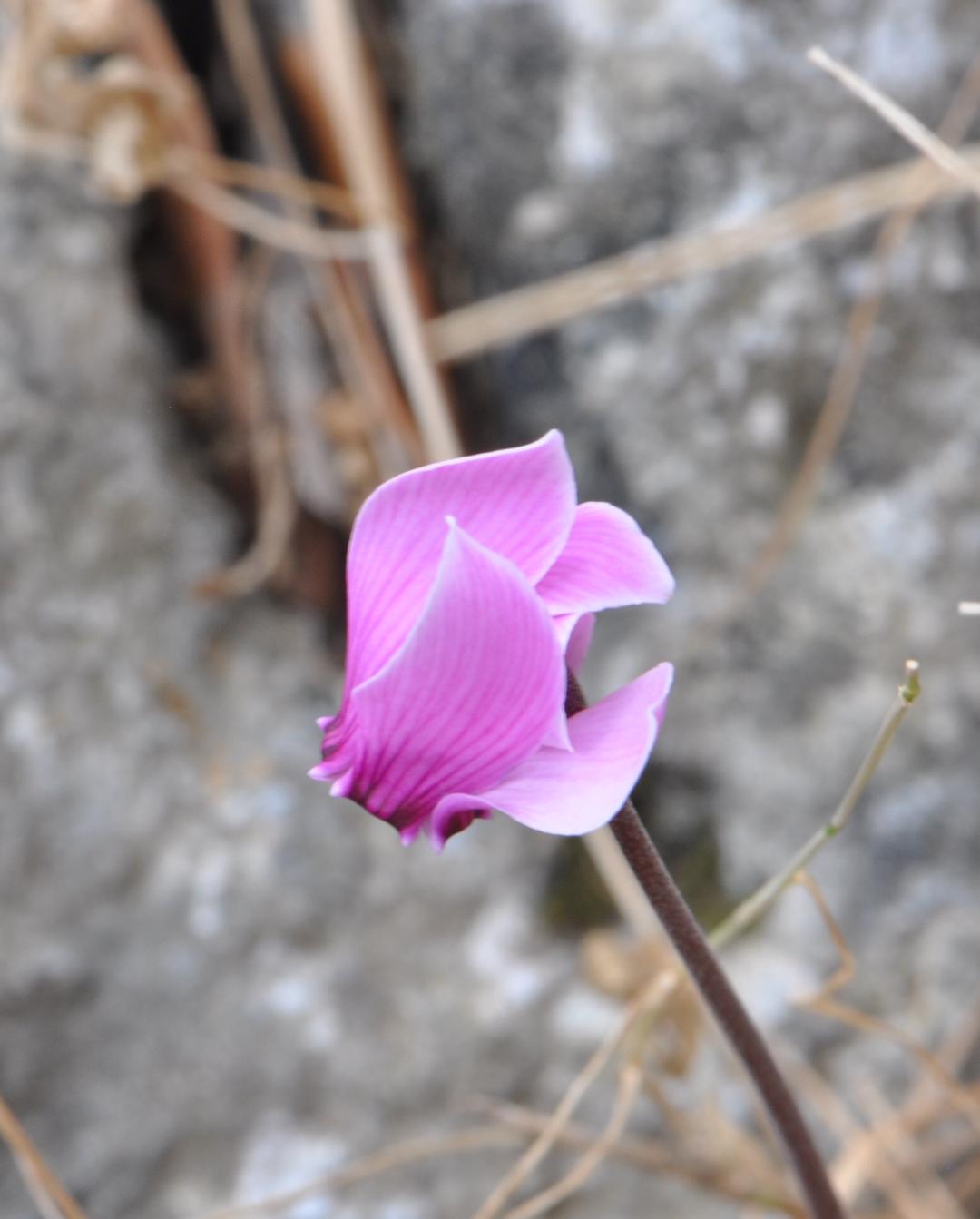
Cyclamen graecum ssp. with white edging to petals

Sternbergia sicula
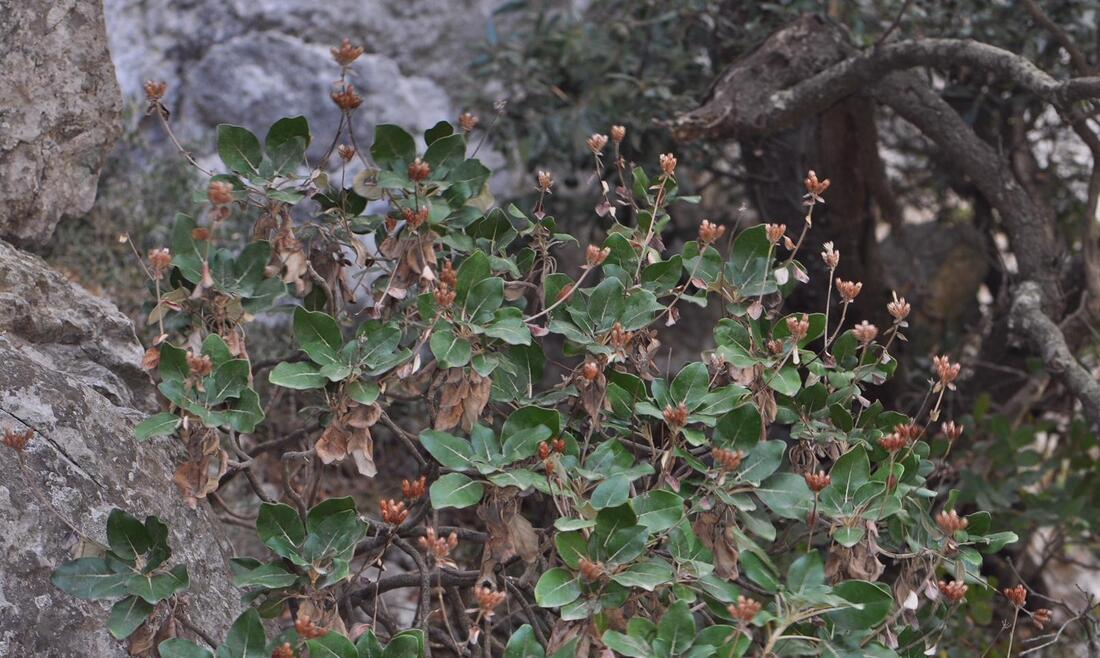
Staehelina arborea
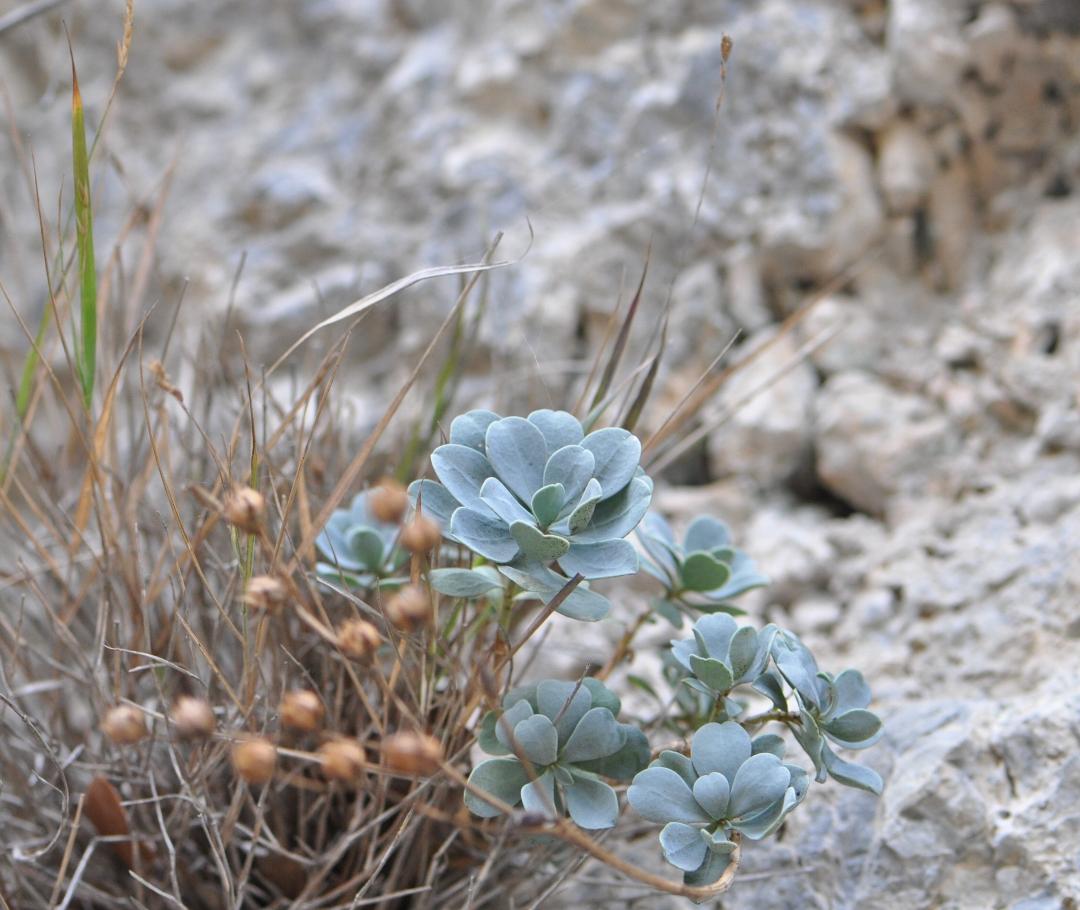
Linum arboreum
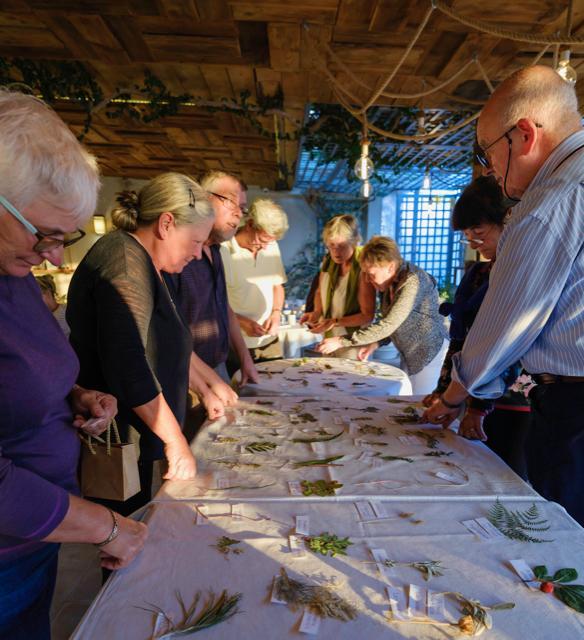
Early in the evening we gathered at a local restaurant for John’s “piece de resistance”, a huge collection of plant specimens from our tour laid out on the tables. We were then handed typed labels with plant names or plant families such as Asperagaceae or Lilliaceae to match all his specimens with. We worked hard at the identification, spread out over several tables in the middle of the room and intrigued a couple of the restaurant’s staff who were amazed to see such an extensive collection so late in the year. Several members knew the vast majority, leaving the rest of us struggling. My knowledge of plant families needs improvement.
Our last full day started with a trip to Preveli, stopping for coffee at the Gefyra Taverna beside the beautiful 18th century disused bridge. John pointed out another of the introduced plant species, Xanthium stramosum, with strange hooked zeppelin-like fruit and the obligatory spines to prevent grazing. We headed on down to the coast, splitting our group once again so that some could explore Preveli Monastery nearby. The walk down the cliff offered spectacular views out to sea, with a special lookout giving first glimpses of the endemic palms at the mouth of the Koutaliotiko gorge below.
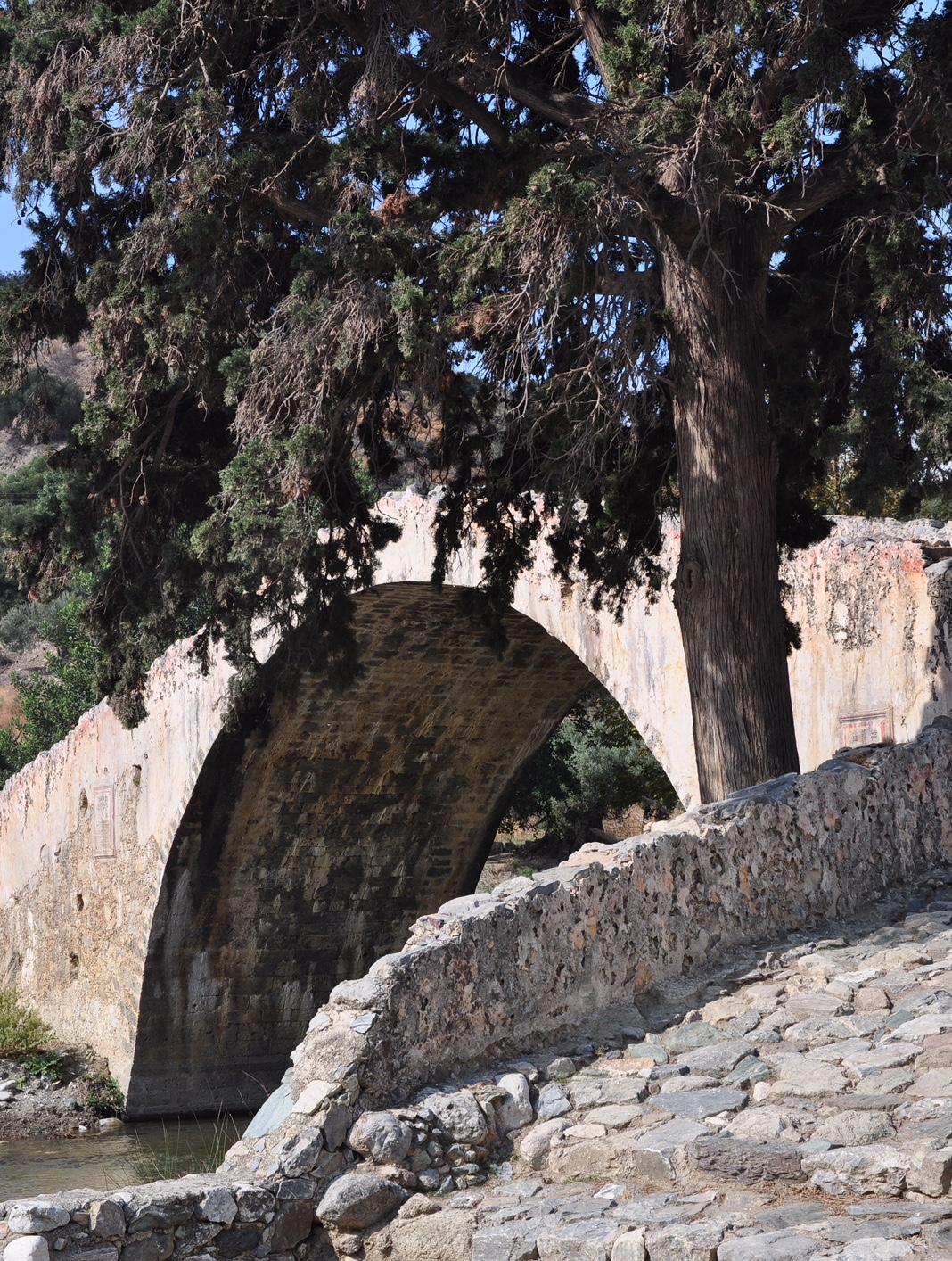
Redundant road bridge
Preveli Beach is one of the few refuges of Phoenix theophrastii which is endemic to the island. It was feared these palms had suffered irreparable damage nine years ago when a fire swept through the grove in August, started in four different places. Strong winds meant that airborne firefighting was impossible and at one point the monastery itself was under threat. Astonishingly the blackened trunks of the palms did sprout again, showing how apposite their botanical name is. The current, major threat to their survival has no such precedent. Red palm weevil grubs, which originated in Asia, have been eating out the hearts of palm trees all over the Mediterannean, killing any they inhabit.
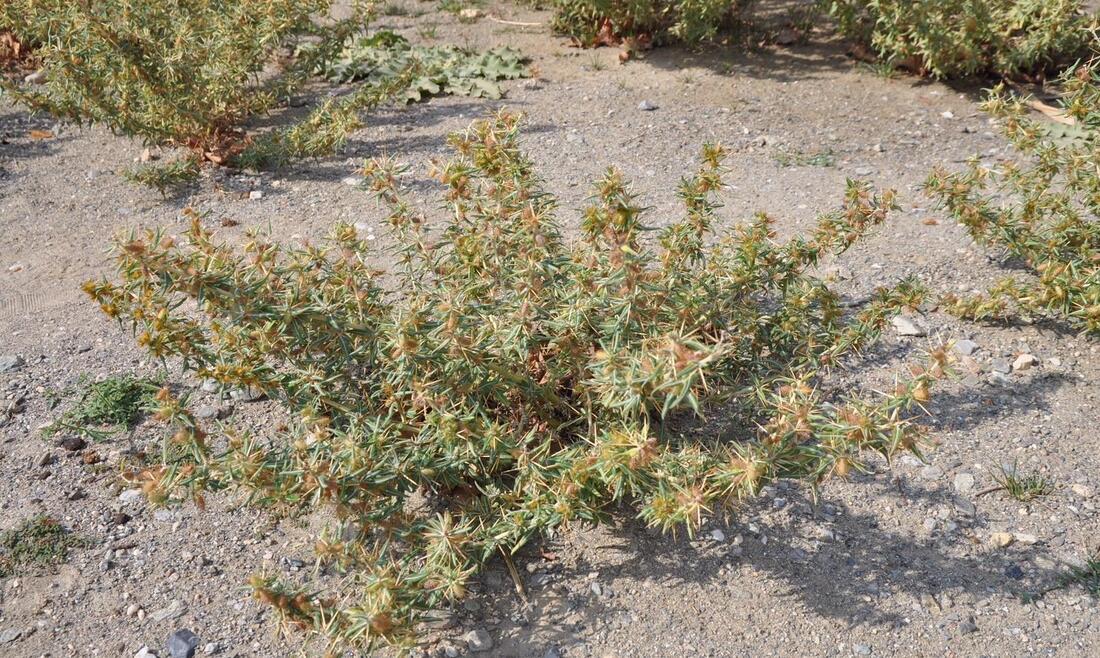
Xanthium stramosum
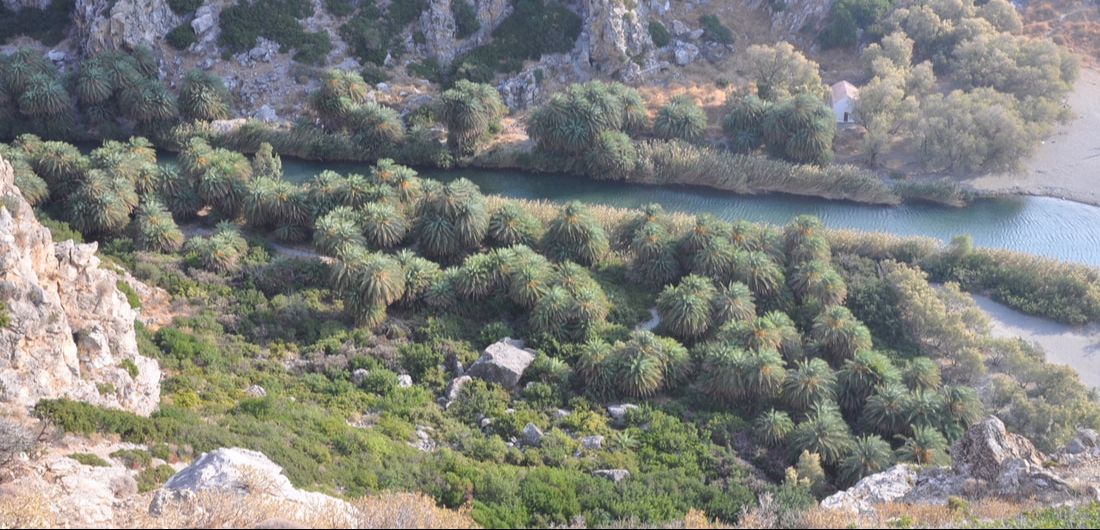
Phoenix theophrasti at Preveli
The other famous native grove, at Vai, near Palekastro has not survived their attack. It was a real privilege to see this grove and sobering to hear just how vulnerable the trees are. On the way back, tucked in amongst the palm trees was an enormous boulder full of Sternbergia sicula in bud and nearby was an excellent specimen of rock samphire, Crithmum maritimum in full flower.
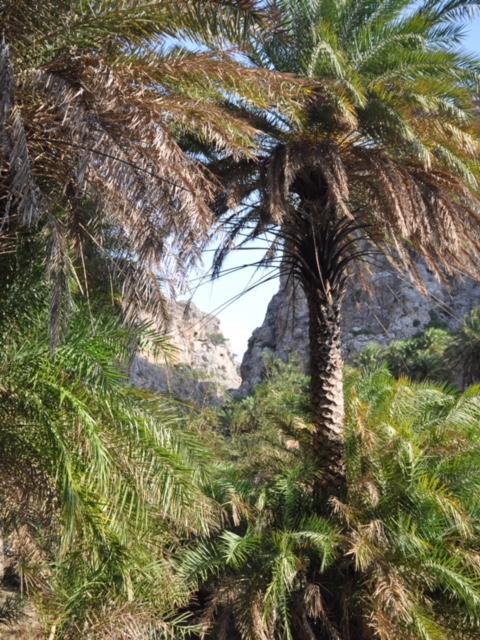
Recovered palm tree showing blackened fire damage
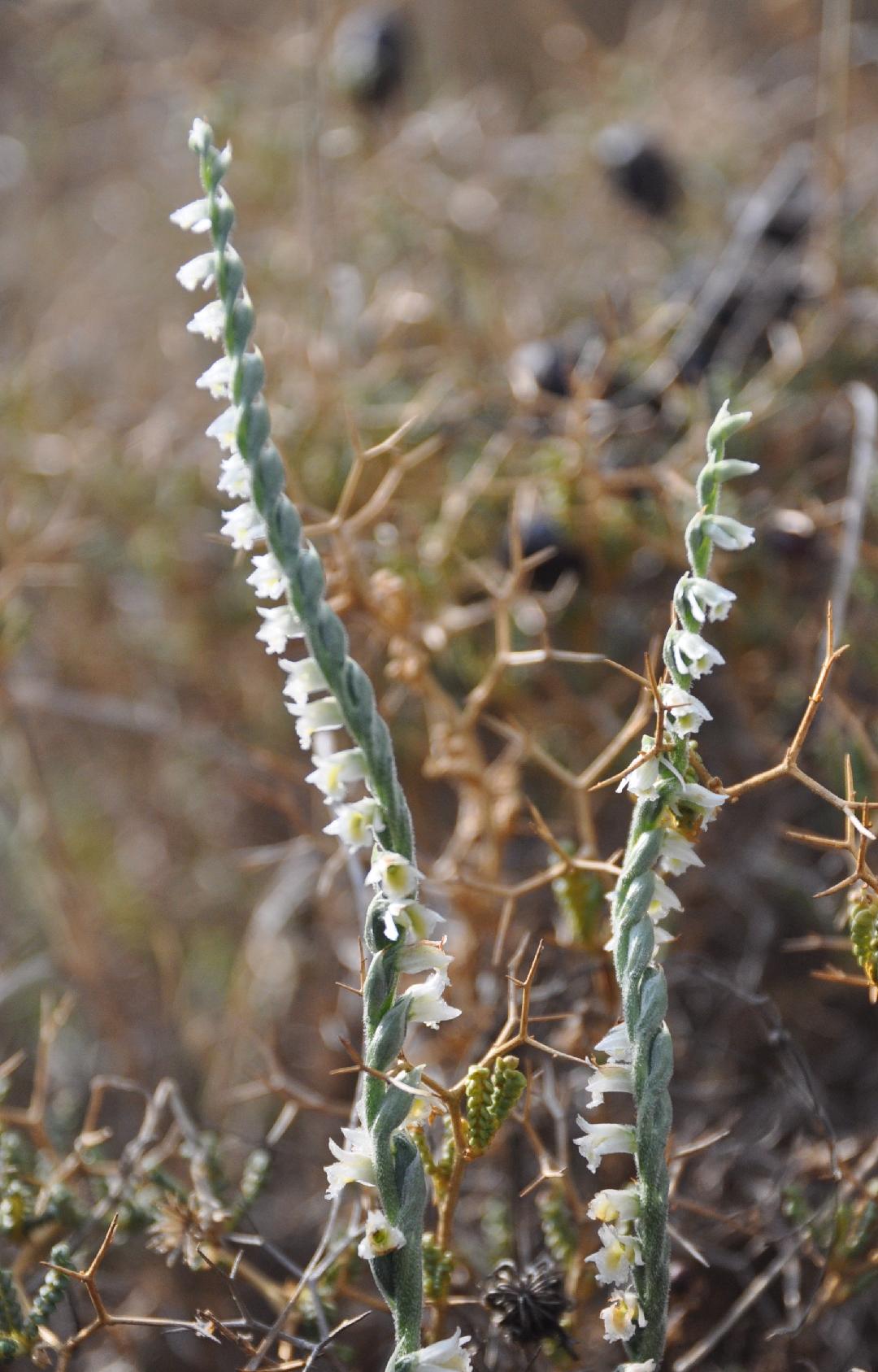
Spiranthes spiralis
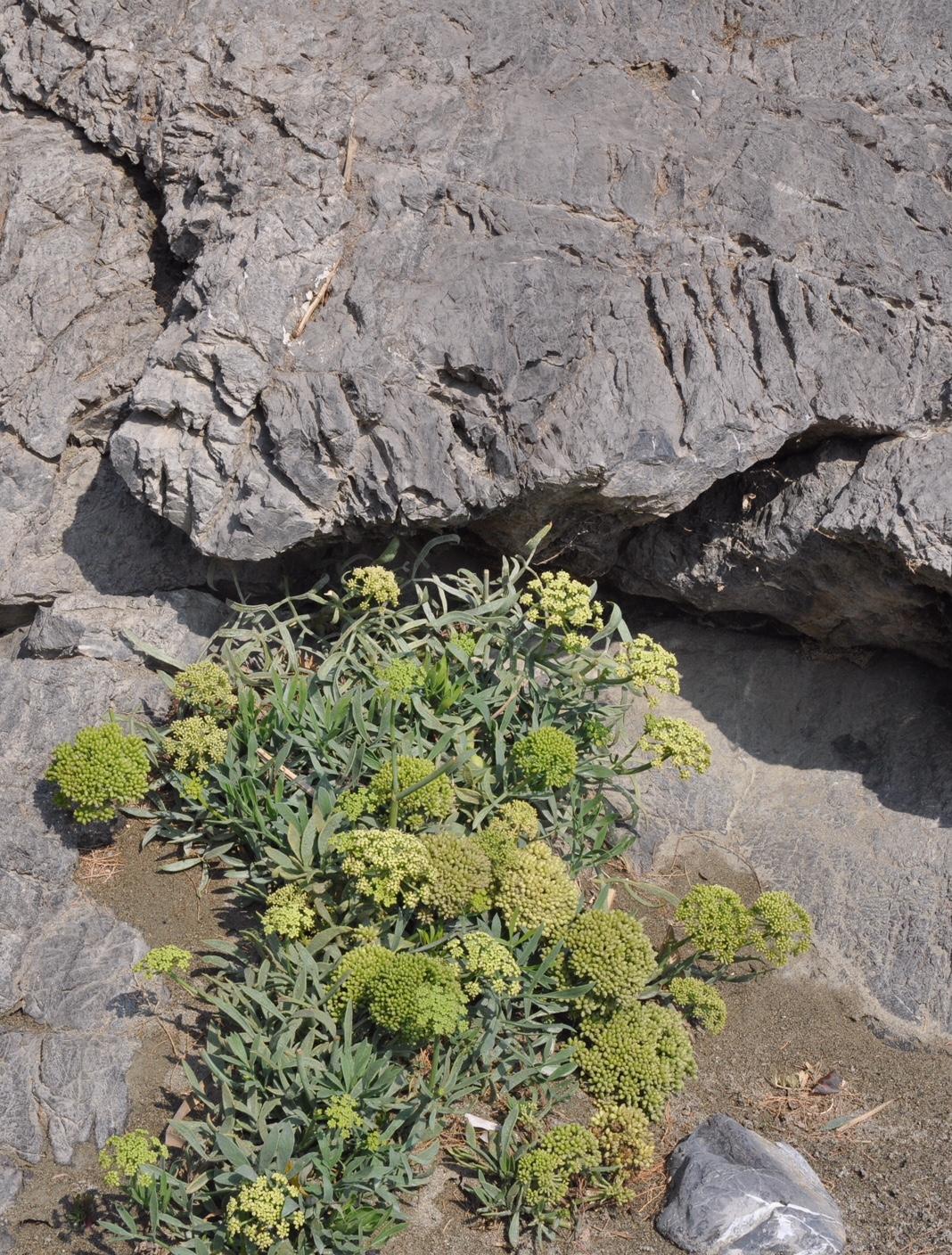
Crithmum maritimum
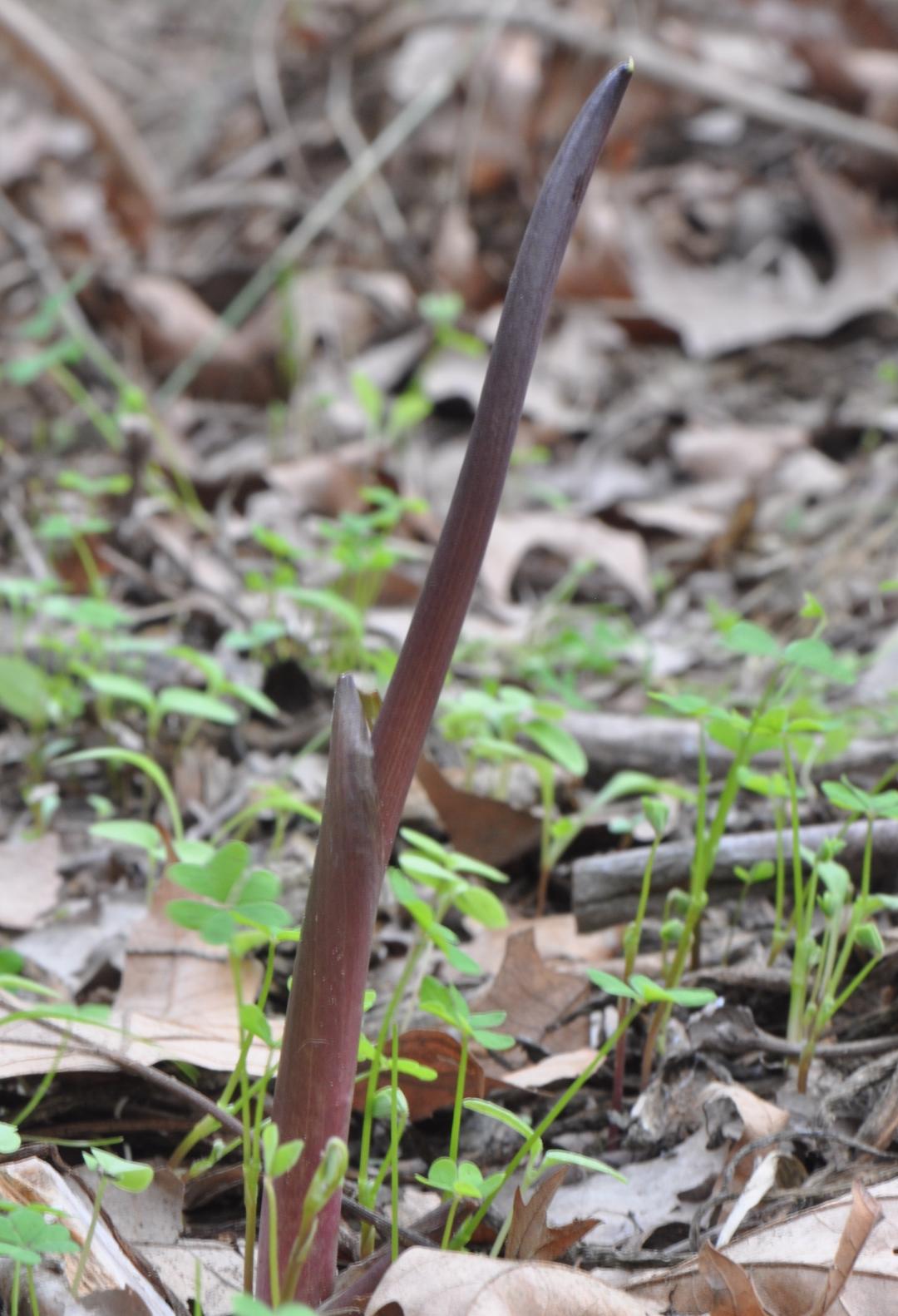
Biarum tenuifolium ssp. idomineum
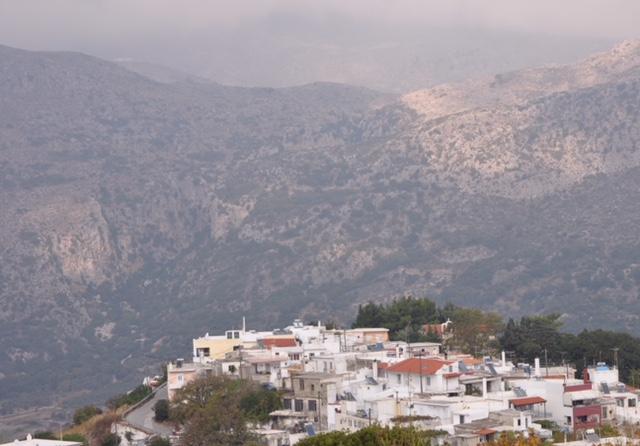
A late lunch in Spili meant we dodged a decent shower of rain before heading on to Aktounda village. We walked up a rough track into the phrygana looking for Spiranthes spiralis, the only autumn-flowering orchid in Crete. We found plenty more Prospero autumnalis and Colchicum pusilum sheltering in the spiny phrygana but it took a while to find any flowering spikes of Spiranthes at all. The previous week’s hundreds had been grazed down to a few short individuals by a local flock of sheep. We had better luck and more shelter for the photographers lower down our track. Close to the village, a shady site under trees turned up an unexpected find, Biarum tenuifolium ssp. John thought this was most probably Biarum tenuifolium ssp. idomineum. The dark maroon spike was not yet fully open but was already about 21cm tall. It was growing with another aroid just coming into leaf, probably Arum creticum.
We left Plakias for the flights home on 24 October, stopping at Lake Kournas, the only natural fresh water lake in Crete, en route to Chania airport. Perhaps due to its popularity with tourists, the beach front is heavily trampled with little of interest but to either side are groves of Styrax officinalis and Vitex agnus-casti, including the white-flowered form. The slopes across the lake are known to be much more diverse botanically but there were flights to catch!
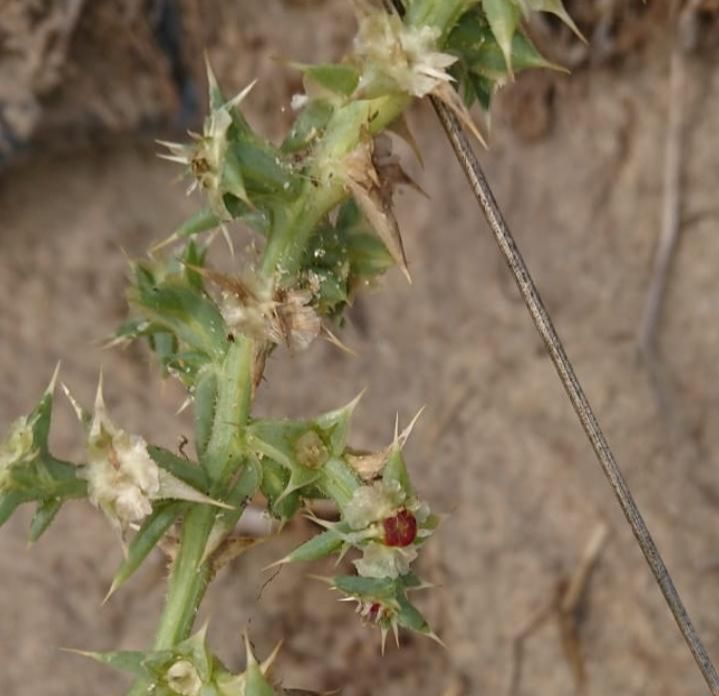
Salsola kali
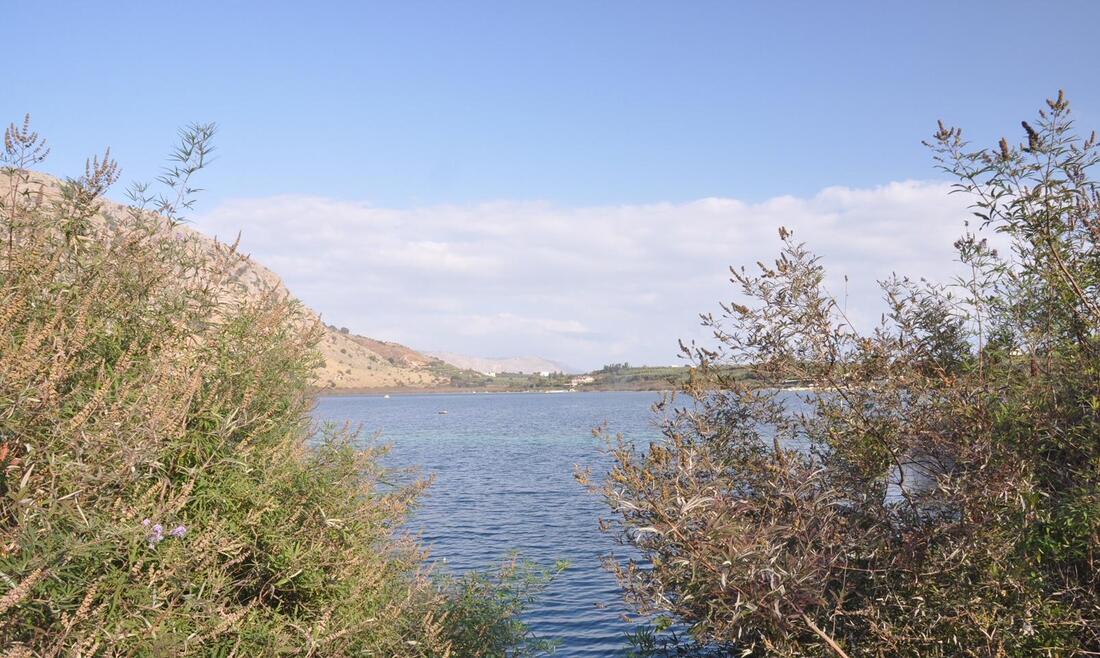
Lake Kournas
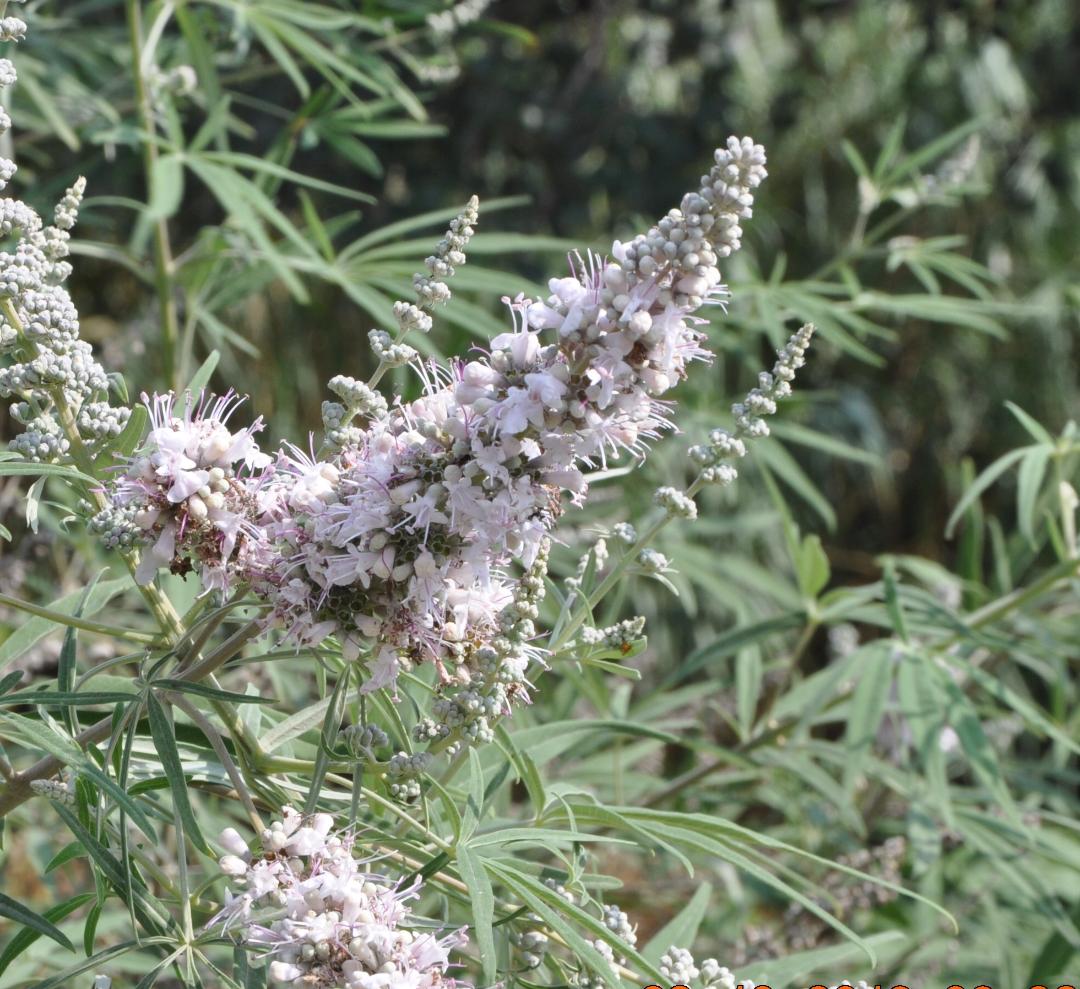
Vitex agnus-casti var. alba
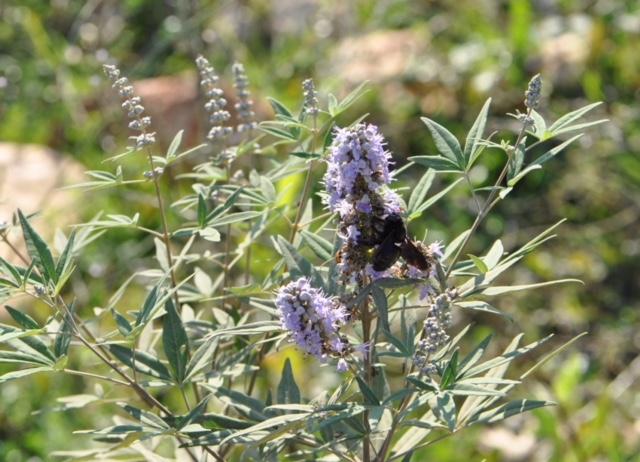
Vitex agnus-casti
I left the party at Georgioupoli, enjoying a day on the beach before my late flight home. There was an interesting salt-tolerant plant growing right next to me, prickly saltwort, Salsola kali. Enjoying the late sunshine I had time to reflect on both an extensive and wide-ranging trip within Crete and also the clever way in which the organisers had managed to cater for so many interests and abilities in one week’s trip. Thank you MPG.

